
deeplake
Database for AI. Store Vectors, Images, Texts, Videos, etc. Use with LLMs/LangChain. Store, query, version, & visualize any AI data. Stream data in real-time to PyTorch/TensorFlow. https://activeloop.ai
Stars: 8804
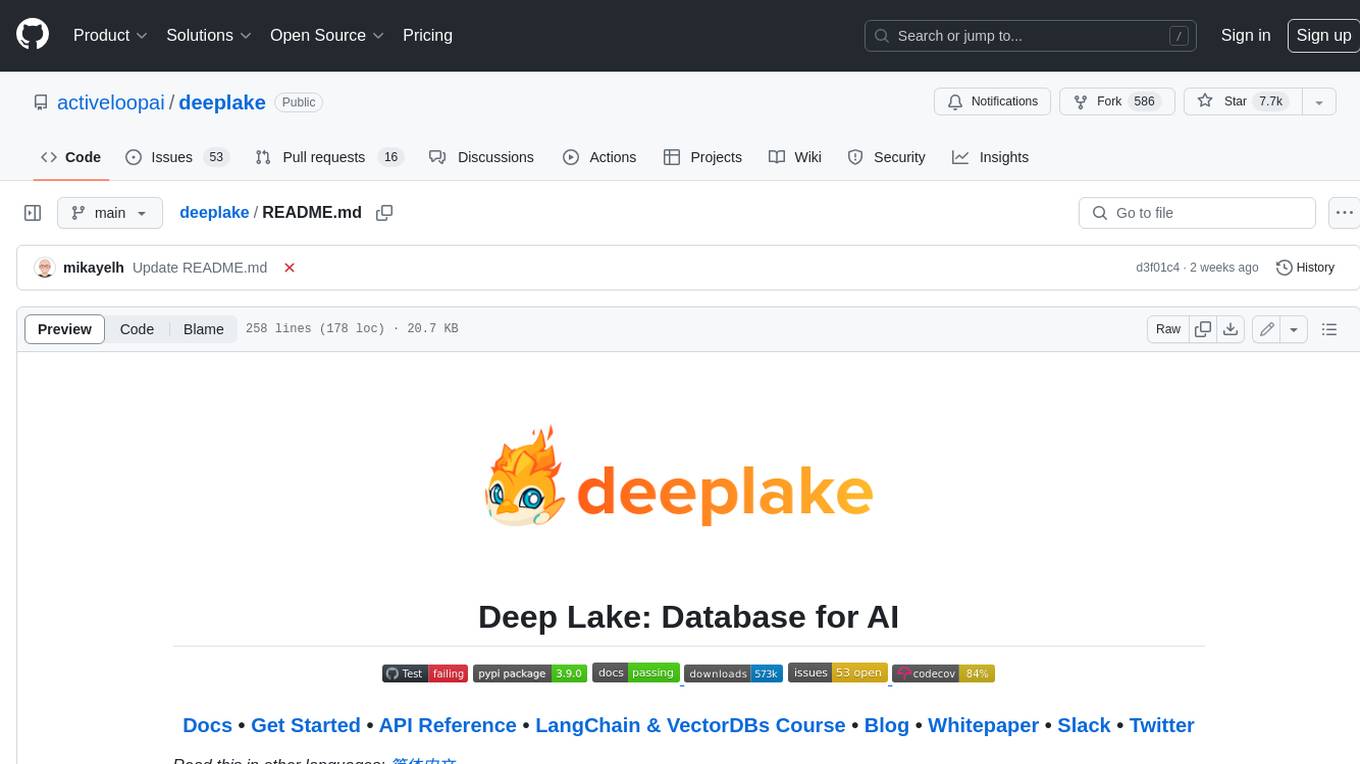
Deep Lake is a Database for AI powered by a storage format optimized for deep-learning applications. Deep Lake can be used for: 1. Storing data and vectors while building LLM applications 2. Managing datasets while training deep learning models Deep Lake simplifies the deployment of enterprise-grade LLM-based products by offering storage for all data types (embeddings, audio, text, videos, images, pdfs, annotations, etc.), querying and vector search, data streaming while training models at scale, data versioning and lineage, and integrations with popular tools such as LangChain, LlamaIndex, Weights & Biases, and many more. Deep Lake works with data of any size, it is serverless, and it enables you to store all of your data in your own cloud and in one place. Deep Lake is used by Intel, Bayer Radiology, Matterport, ZERO Systems, Red Cross, Yale, & Oxford.
README:
Docs • Get Started • API Reference • LangChain & VectorDBs Course • Blog • Whitepaper • Slack • Twitter
Deep Lake is a Database for AI powered by a storage format optimized for deep-learning applications. Deep Lake can be used for:
- Storing and searching data plus vectors while building LLM applications
- Managing datasets while training deep learning models
Deep Lake simplifies the deployment of enterprise-grade LLM-based products by offering storage for all data types (embeddings, audio, text, videos, images, dicom, pdfs, annotations, and more), querying and vector search, data streaming while training models at scale, data versioning and lineage, and integrations with popular tools such as LangChain, LlamaIndex, Weights & Biases, and many more. Deep Lake works with data of any size, it is serverless, and it enables you to store all of your data in your own cloud and in one place. Deep Lake is used by Intel, Bayer Radiology, Matterport, ZERO Systems, Red Cross, Yale, & Oxford.
Multi-Cloud Support (S3, GCP, Azure)
Use one API to upload, download, and stream datasets to/from S3, Azure, GCP, Activeloop cloud, local storage, or in-memory storage. Compatible with any S3-compatible storage such as MinIO.Native Compression with Lazy NumPy-like Indexing
Store images, audio, and videos in their native compression. Slice, index, iterate, and interact with your data like a collection of NumPy arrays in your system's memory. Deep Lake lazily loads data only when needed, e.g., when training a model or running queries.Dataloaders for Popular Deep Learning Frameworks
Deep Lake comes with built-in dataloaders for Pytorch and TensorFlow. Train your model with a few lines of code - we even take care of dataset shuffling. :)Integrations with Powerful Tools
Deep Lake has integrations with Langchain and LLamaIndex as a vector store for LLM apps, Weights & Biases for data lineage during model training, MMDetection for training object detection models, and MMSegmentation for training semantic segmentation models.100+ most-popular image, video, and audio datasets available in seconds
Deep Lake community has uploaded 100+ image, video and audio datasets like MNIST, COCO, ImageNet, CIFAR, GTZAN and others.Instant Visualization Support in the Deep Lake App
Deep Lake datasets are instantly visualized with bounding boxes, masks, annotations, etc. in Deep Lake Visualizer (see below).Deep Lake can be installed using pip:
pip install deeplakeTo access all of Deep Lake's features, please register in the Deep Lake App.
Using Deep Lake as a Vector Store for building LLM applications:
Using Deep Lake for managing data while training Deep Learning models:
Deep Lake offers integrations with other tools in order to streamline your deep learning workflows. Current integrations include:
-
LLM Apps
- Use Deep Lake as a vector store for LLM apps. Our integration combines the Langchain VectorStores API with Deep Lake datasets as the underlying data storage. The integration is a serverless vector store that can be deployed locally or in a cloud of your choice.
Getting started guides, examples, tutorials, API reference, and other useful information can be found on our documentation page.
Deep Lake users can access and visualize a variety of popular datasets through a free integration with Deep Lake's App. Universities can get up to 1TB of data storage and 100,000 monthly queries on the Tensor Database for free per month. Chat in on our website: to claim the access!
Deep Lake vs Chroma
Both Deep Lake & ChromaDB enable users to store and search vectors (embeddings) and offer integrations with LangChain and LlamaIndex. However, they are architecturally very different. ChromaDB is a Vector Database that can be deployed locally or on a server using Docker and will offer a hosted solution shortly. Deep Lake is a serverless Vector Store deployed on the user’s own cloud, locally, or in-memory. All computations run client-side, which enables users to support lightweight production apps in seconds. Unlike ChromaDB, Deep Lake’s data format can store raw data such as images, videos, and text, in addition to embeddings. ChromaDB is limited to light metadata on top of the embeddings and has no visualization. Deep Lake datasets can be visualized and version controlled. Deep Lake also has a performant dataloader for fine-tuning your Large Language Models.
Deep Lake vs Pinecone
Both Deep Lake and Pinecone enable users to store and search vectors (embeddings) and offer integrations with LangChain and LlamaIndex. However, they are architecturally very different. Pinecone is a fully-managed Vector Database that is optimized for highly demanding applications requiring a search for billions of vectors. Deep Lake is serverless. All computations run client-side, which enables users to get started in seconds. Unlike Pinecone, Deep Lake’s data format can store raw data such as images, videos, and text, in addition to embeddings. Deep Lake datasets can be visualized and version controlled. Pinecone is limited to light metadata on top of the embeddings and has no visualization. Deep Lake also has a performant dataloader for fine-tuning your Large Language Models.
Deep Lake vs Weaviate
Both Deep Lake and Weaviate enable users to store and search vectors (embeddings) and offer integrations with LangChain and LlamaIndex. However, they are architecturally very different. Weaviate is a Vector Database that can be deployed in a managed service or by the user via Kubernetes or Docker. Deep Lake is serverless. All computations run client-side, which enables users to support lightweight production apps in seconds. Unlike Weaviate, Deep Lake’s data format can store raw data such as images, videos, and text, in addition to embeddings. Deep Lake datasets can be visualized and version controlled. Weaviate is limited to light metadata on top of the embeddings and has no visualization. Deep Lake also has a performant dataloader for fine-tuning your Large Language Models.
Deep Lake vs DVC
Deep Lake and DVC offer dataset version control similar to git for data, but their methods for storing data differ significantly. Deep Lake converts and stores data as chunked compressed arrays, which enables rapid streaming to ML models, whereas DVC operates on top of data stored in less efficient traditional file structures. The Deep Lake format makes dataset versioning significantly easier compared to traditional file structures by DVC when datasets are composed of many files (i.e., many images). An additional distinction is that DVC primarily uses a command-line interface, whereas Deep Lake is a Python package. Lastly, Deep Lake offers an API to easily connect datasets to ML frameworks and other common ML tools and enables instant dataset visualization through Activeloop's visualization tool.
Deep Lake vs MosaicML MDS format
- Data Storage Format: Deep Lake operates on a columnar storage format, whereas MDS utilizes a row-wise storage approach. This fundamentally impacts how data is read, written, and organized in each system.
- Compression: Deep Lake offers a more flexible compression scheme, allowing control over both chunk-level and sample-level compression for each column or tensor. This feature eliminates the need for additional compressions like zstd, which would otherwise demand more CPU cycles for decompressing on top of formats like jpeg.
- Shuffling: MDS currently offers more advanced shuffling strategies.
- Version Control & Visualization Support: A notable feature of Deep Lake is its native version control and in-browser data visualization, a feature not present for MosaicML data format. This can provide significant advantages in managing, understanding, and tracking different versions of the data.
Deep Lake vs TensorFlow Datasets (TFDS)
Deep Lake and TFDS seamlessly connect popular datasets to ML frameworks. Deep Lake datasets are compatible with both PyTorch and TensorFlow, whereas TFDS are only compatible with TensorFlow. A key difference between Deep Lake and TFDS is that Deep Lake datasets are designed for streaming from the cloud, whereas TFDS must be downloaded locally prior to use. As a result, with Deep Lake, one can import datasets directly from TensorFlow Datasets and stream them either to PyTorch or TensorFlow. In addition to providing access to popular publicly available datasets, Deep Lake also offers powerful tools for creating custom datasets, storing them on a variety of cloud storage providers, and collaborating with others via simple API. TFDS is primarily focused on giving the public easy access to commonly available datasets, and management of custom datasets is not the primary focus. A full comparison article can be found here.
Deep Lake vs HuggingFace
Deep Lake and HuggingFace offer access to popular datasets, but Deep Lake primarily focuses on computer vision, whereas HuggingFace focuses on natural language processing. HuggingFace Transforms and other computational tools for NLP are not analogous to features offered by Deep Lake.Deep Lake vs WebDatasets
Deep Lake and WebDatasets both offer rapid data streaming across networks. They have nearly identical steaming speeds because the underlying network requests and data structures are very similar. However, Deep Lake offers superior random access and shuffling, its simple API is in python instead of command-line, and Deep Lake enables simple indexing and modification of the dataset without having to recreate it.Deep Lake vs Zarr
Deep Lake and Zarr both offer storage of data as chunked arrays. However, Deep Lake is primarily designed for returning data as arrays using a simple API, rather than actually storing raw arrays (even though that's also possible). Deep Lake stores data in use-case-optimized formats, such as jpeg or png for images, or mp4 for video, and the user treats the data as if it's an array, because Deep Lake handles all the data processing in between. Deep Lake offers more flexibility for storing arrays with dynamic shape (ragged tensors), and it provides several features that are not naively available in Zarr such as version control, data streaming, and connecting data to ML Frameworks.Join our Slack community to learn more about unstructured dataset management using Deep Lake and to get help from the Activeloop team and other users.
We'd love your feedback by completing our 3-minute survey.
As always, thanks to our amazing contributors!
Made with contributors-img.
Please read CONTRIBUTING.md to get started with making contributions to Deep Lake.
Using Deep Lake? Add a README badge to let everyone know:
[](https://github.com/activeloopai/deeplake)Dataset Licenses
Deep Lake users may have access to a variety of publicly available datasets. We do not host or distribute these datasets, vouch for their quality or fairness, or claim that you have a license to use the datasets. It is your responsibility to determine whether you have permission to use the datasets under their license.
If you're a dataset owner and do not want your dataset to be included in this library, please get in touch through a GitHub issue. Thank you for your contribution to the ML community!
If you use Deep Lake in your research, please cite Activeloop using:
@article{deeplake,
title = {Deep Lake: a Lakehouse for Deep Learning},
author = {Hambardzumyan, Sasun and Tuli, Abhinav and Ghukasyan, Levon and Rahman, Fariz and Topchyan, Hrant and Isayan, David and Harutyunyan, Mikayel and Hakobyan, Tatevik and Stranic, Ivo and Buniatyan, Davit},
url = {https://www.cidrdb.org/cidr2023/papers/p69-buniatyan.pdf},
booktitle={Proceedings of CIDR},
year = {2023},
}This technology was inspired by our research work at Princeton University. We would like to thank William Silversmith @SeungLab for his awesome cloud-volume tool.
For Tasks:
Click tags to check more tools for each tasksFor Jobs:
Alternative AI tools for deeplake
Similar Open Source Tools

deeplake
Deep Lake is a Database for AI powered by a storage format optimized for deep-learning applications. Deep Lake can be used for: 1. Storing data and vectors while building LLM applications 2. Managing datasets while training deep learning models Deep Lake simplifies the deployment of enterprise-grade LLM-based products by offering storage for all data types (embeddings, audio, text, videos, images, pdfs, annotations, etc.), querying and vector search, data streaming while training models at scale, data versioning and lineage, and integrations with popular tools such as LangChain, LlamaIndex, Weights & Biases, and many more. Deep Lake works with data of any size, it is serverless, and it enables you to store all of your data in your own cloud and in one place. Deep Lake is used by Intel, Bayer Radiology, Matterport, ZERO Systems, Red Cross, Yale, & Oxford.
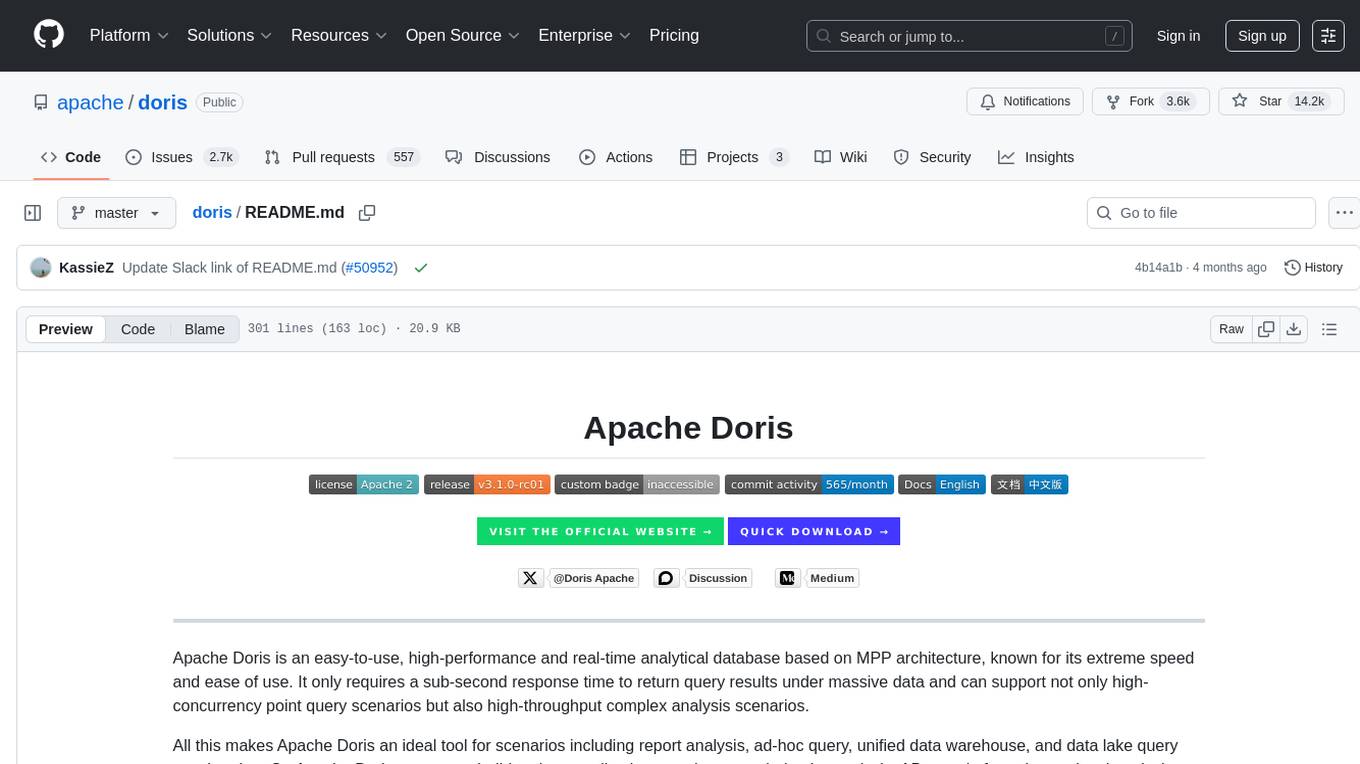
doris
Doris is a lightweight and user-friendly data visualization tool designed for quick and easy exploration of datasets. It provides a simple interface for users to upload their data and generate interactive visualizations without the need for coding. With Doris, users can easily create charts, graphs, and dashboards to analyze and present their data in a visually appealing way. The tool supports various data formats and offers customization options to tailor visualizations to specific needs. Whether you are a data analyst, researcher, or student, Doris simplifies the process of data exploration and presentation.
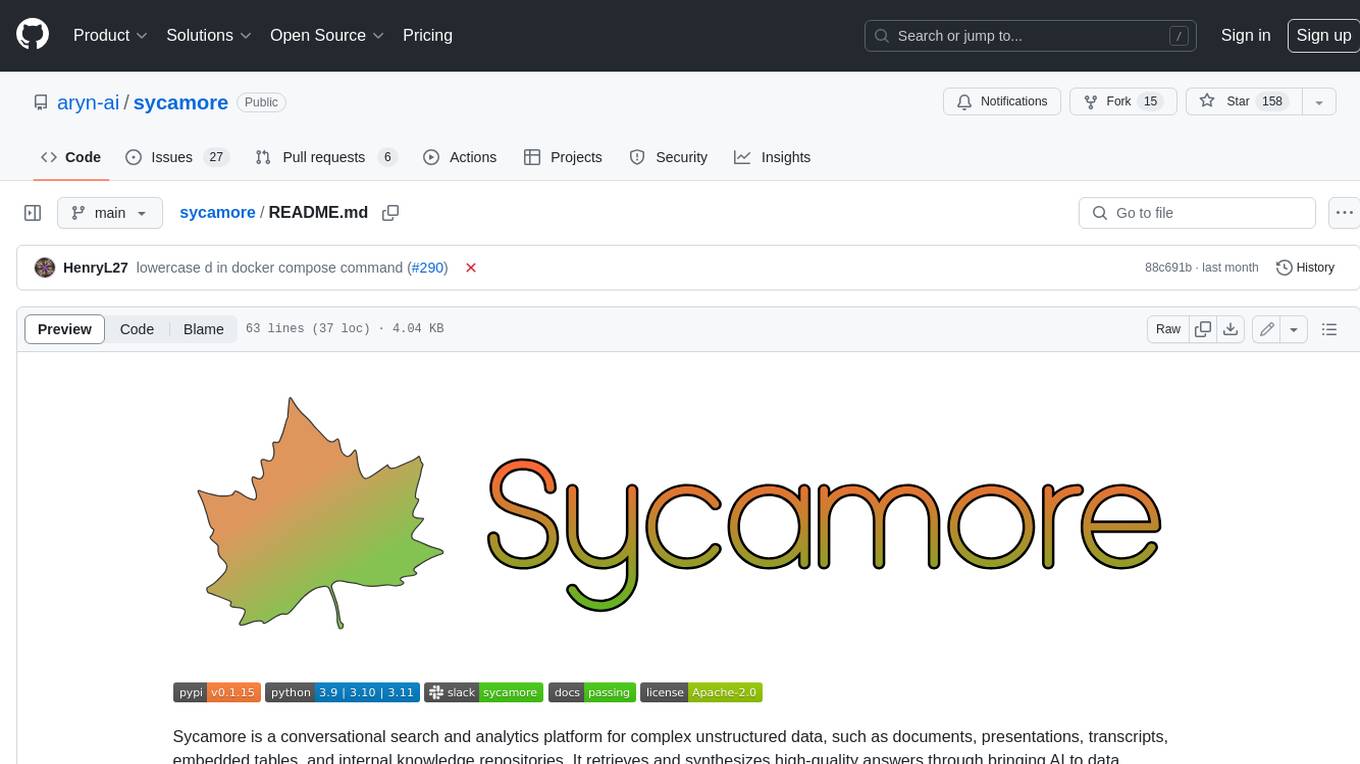
sycamore
Sycamore is a conversational search and analytics platform for complex unstructured data, such as documents, presentations, transcripts, embedded tables, and internal knowledge repositories. It retrieves and synthesizes high-quality answers through bringing AI to data preparation, indexing, and retrieval. Sycamore makes it easy to prepare unstructured data for search and analytics, providing a toolkit for data cleaning, information extraction, enrichment, summarization, and generation of vector embeddings that encapsulate the semantics of data. Sycamore uses your choice of generative AI models to make these operations simple and effective, and it enables quick experimentation and iteration. Additionally, Sycamore uses OpenSearch for indexing, enabling hybrid (vector + keyword) search, retrieval-augmented generation (RAG) pipelining, filtering, analytical functions, conversational memory, and other features to improve information retrieval.
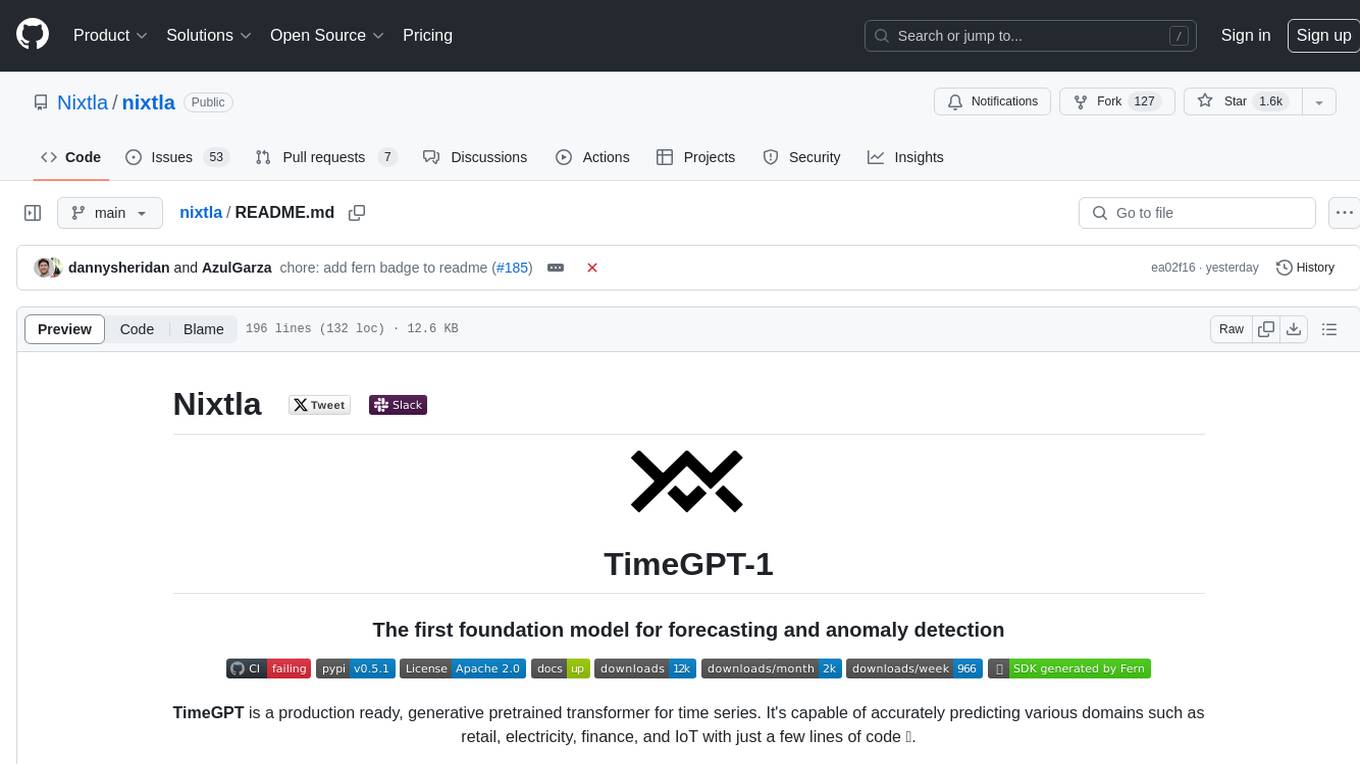
nixtla
Nixtla is a production-ready generative pretrained transformer for time series forecasting and anomaly detection. It can accurately predict various domains such as retail, electricity, finance, and IoT with just a few lines of code. TimeGPT introduces a paradigm shift with its standout performance, efficiency, and simplicity, making it accessible even to users with minimal coding experience. The model is based on self-attention and is independently trained on a vast time series dataset to minimize forecasting error. It offers features like zero-shot inference, fine-tuning, API access, adding exogenous variables, multiple series forecasting, custom loss function, cross-validation, prediction intervals, and handling irregular timestamps.
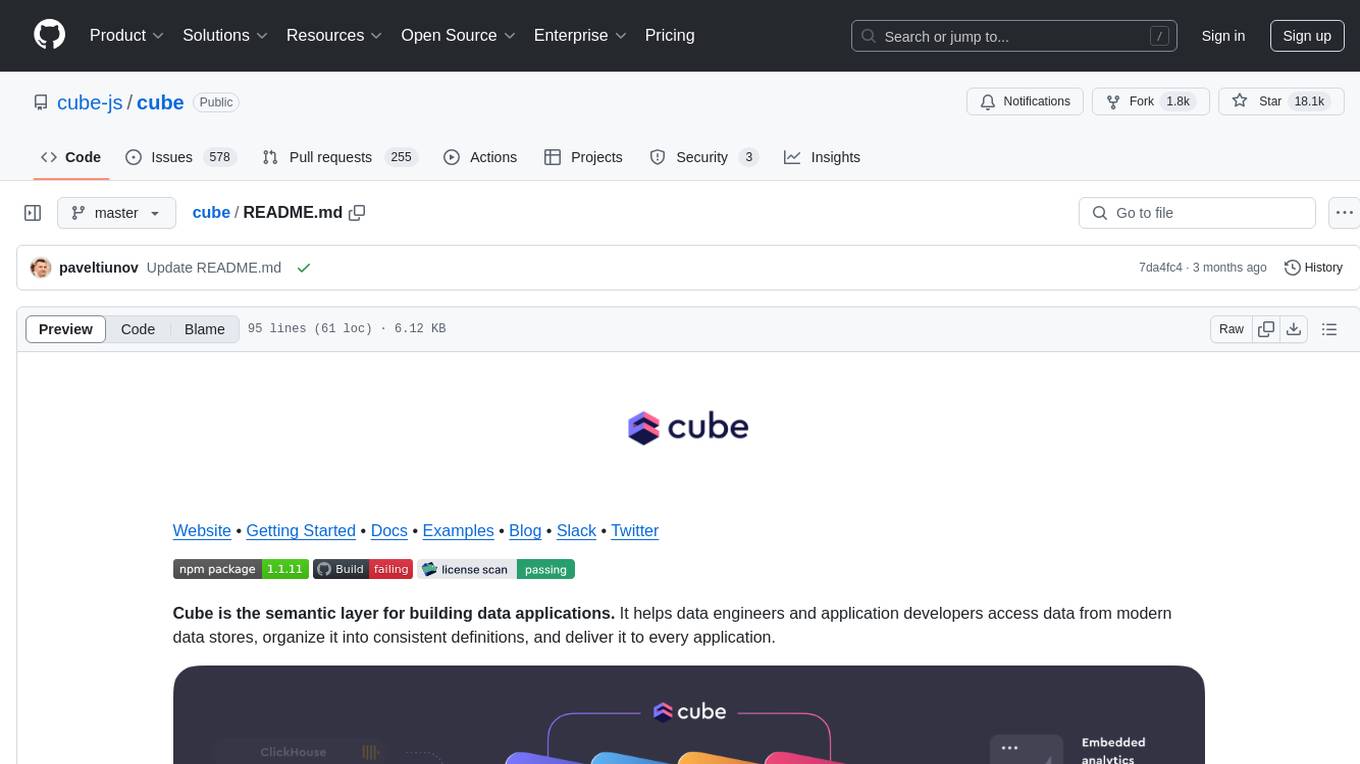
cube
Cube is a semantic layer for building data applications, helping data engineers and application developers access data from modern data stores, organize it into consistent definitions, and deliver it to every application. It works with SQL-enabled data sources, providing sub-second latency and high concurrency for API requests. Cube addresses SQL code organization, performance, and access control issues in data applications, enabling efficient data modeling, access control, and performance optimizations for various tools like embedded analytics, dashboarding, reporting, and data notebooks.
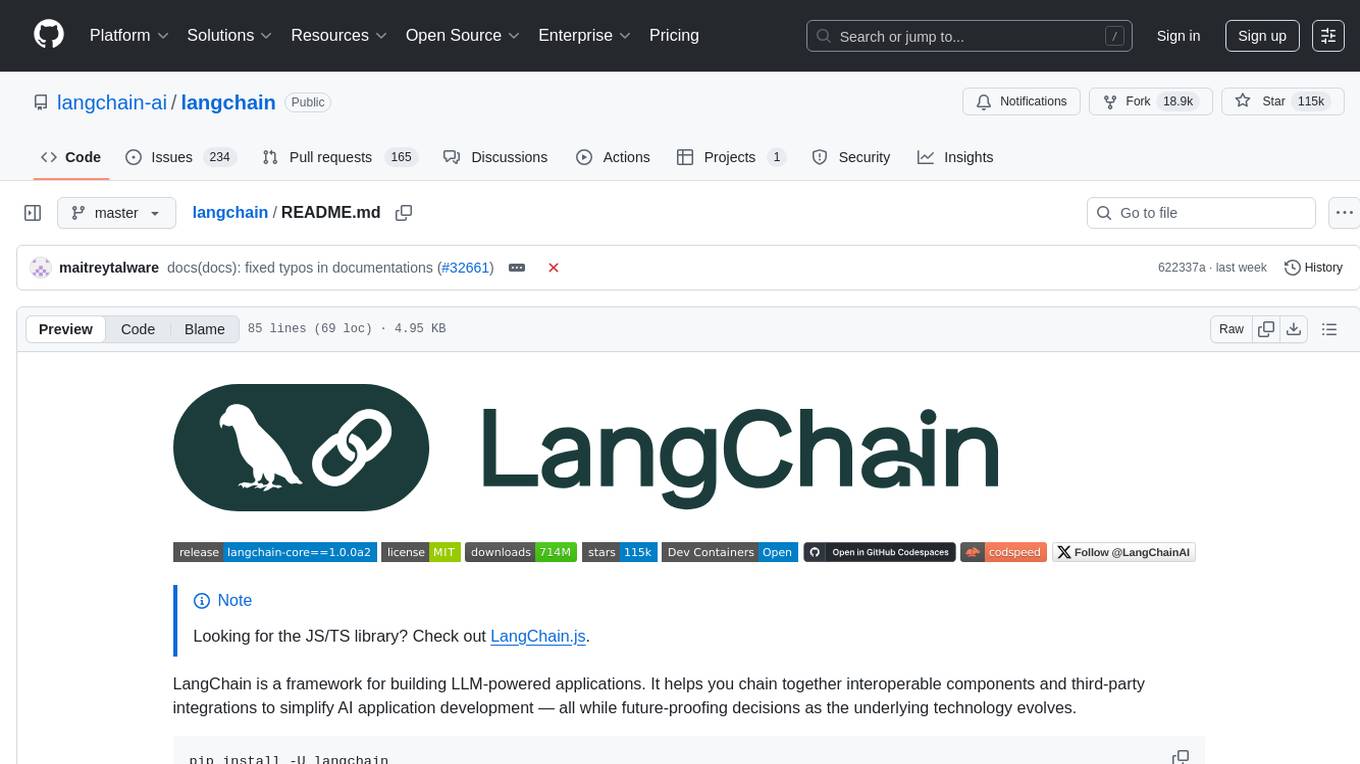
langchain
LangChain is a framework for building LLM-powered applications that simplifies AI application development by chaining together interoperable components and third-party integrations. It helps developers connect LLMs to diverse data sources, swap models easily, and future-proof decisions as technology evolves. LangChain's ecosystem includes tools like LangSmith for agent evals, LangGraph for complex task handling, and LangGraph Platform for deployment and scaling. Additional resources include tutorials, how-to guides, conceptual guides, a forum, API reference, and chat support.
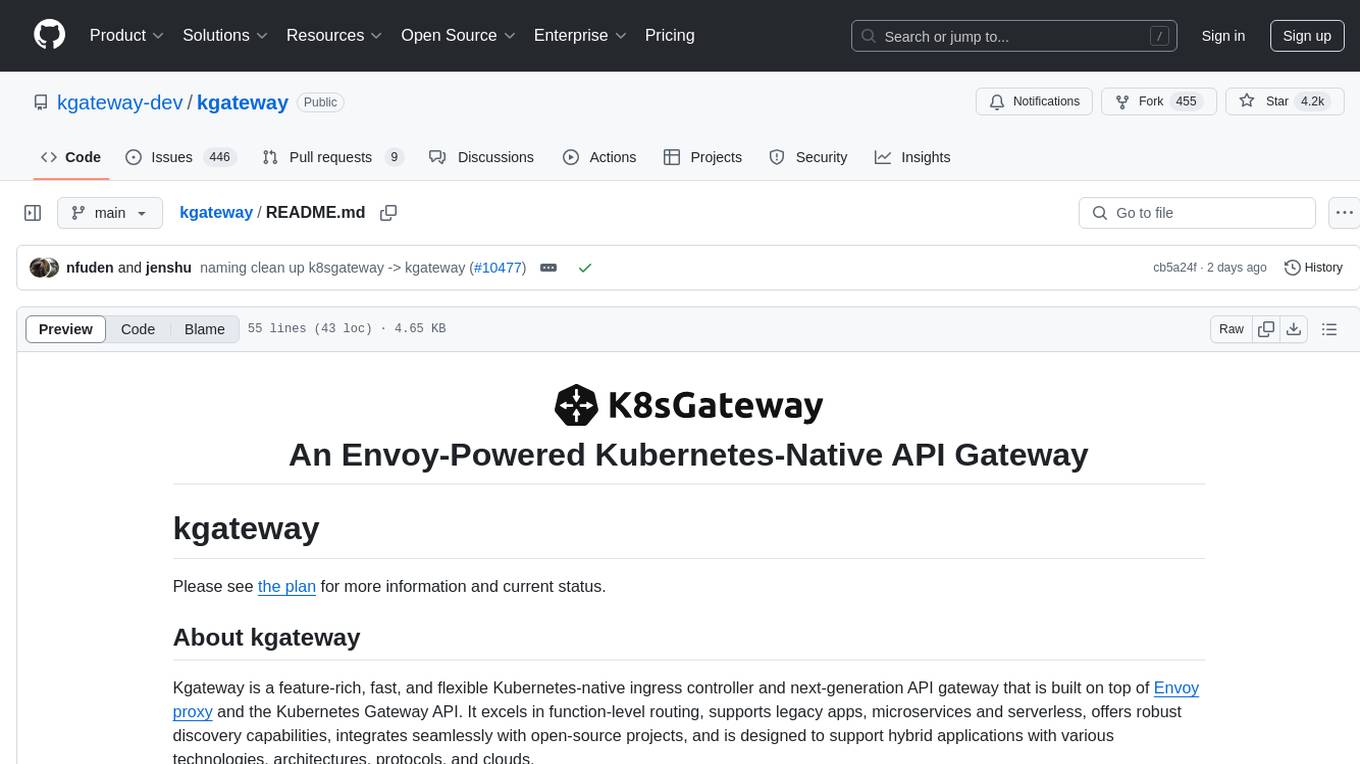
kgateway
Kgateway is a feature-rich, fast, and flexible Kubernetes-native API gateway built on top of Envoy proxy and the Kubernetes Gateway API. It excels in function-level routing, supports legacy apps, microservices, and serverless, offers robust discovery capabilities, integrates seamlessly with open-source projects, and is designed to support hybrid applications with various technologies, architectures, protocols, and clouds.
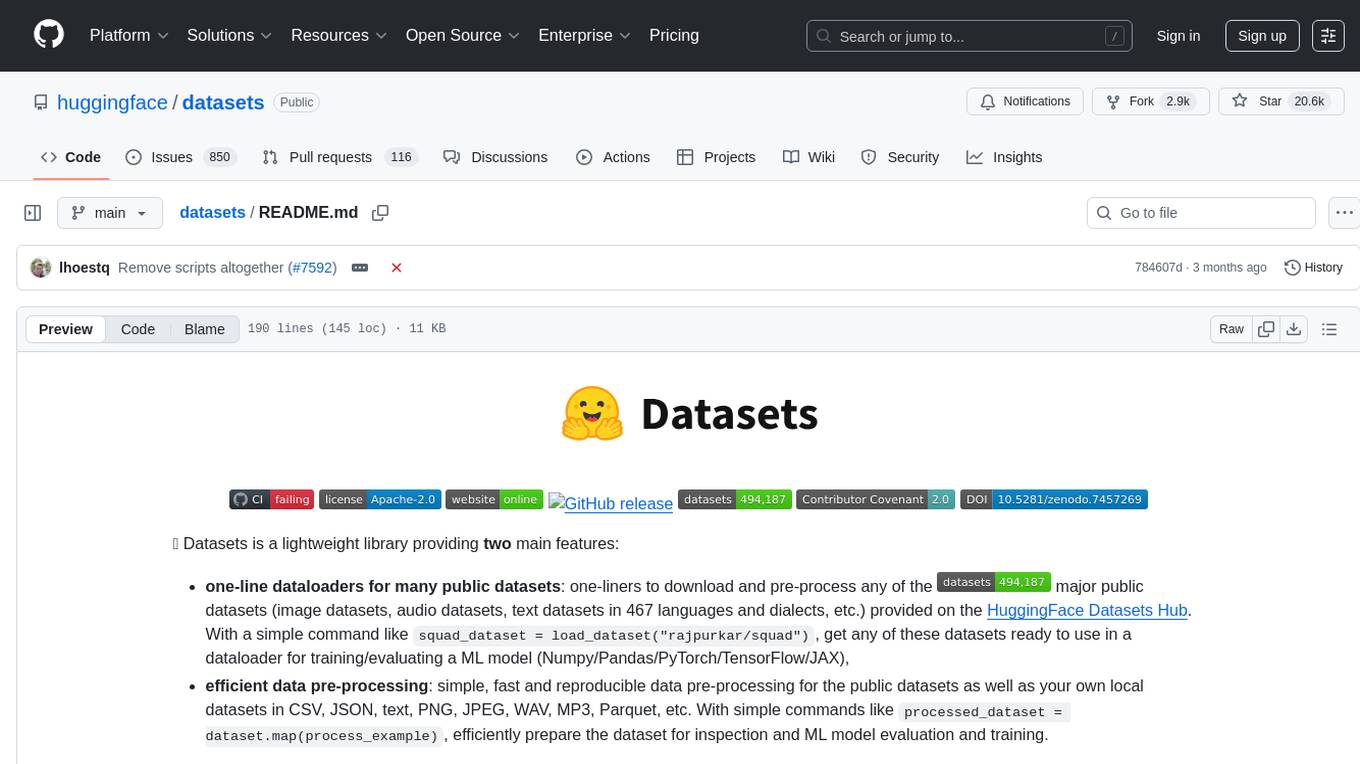
datasets
Datasets is a repository that provides a collection of various datasets for machine learning and data analysis projects. It includes datasets in different formats such as CSV, JSON, and Excel, covering a wide range of topics including finance, healthcare, marketing, and more. The repository aims to help data scientists, researchers, and students access high-quality datasets for training models, conducting experiments, and exploring data analysis techniques.

embedJs
EmbedJs is a NodeJS framework that simplifies RAG application development by efficiently processing unstructured data. It segments data, creates relevant embeddings, and stores them in a vector database for quick retrieval.
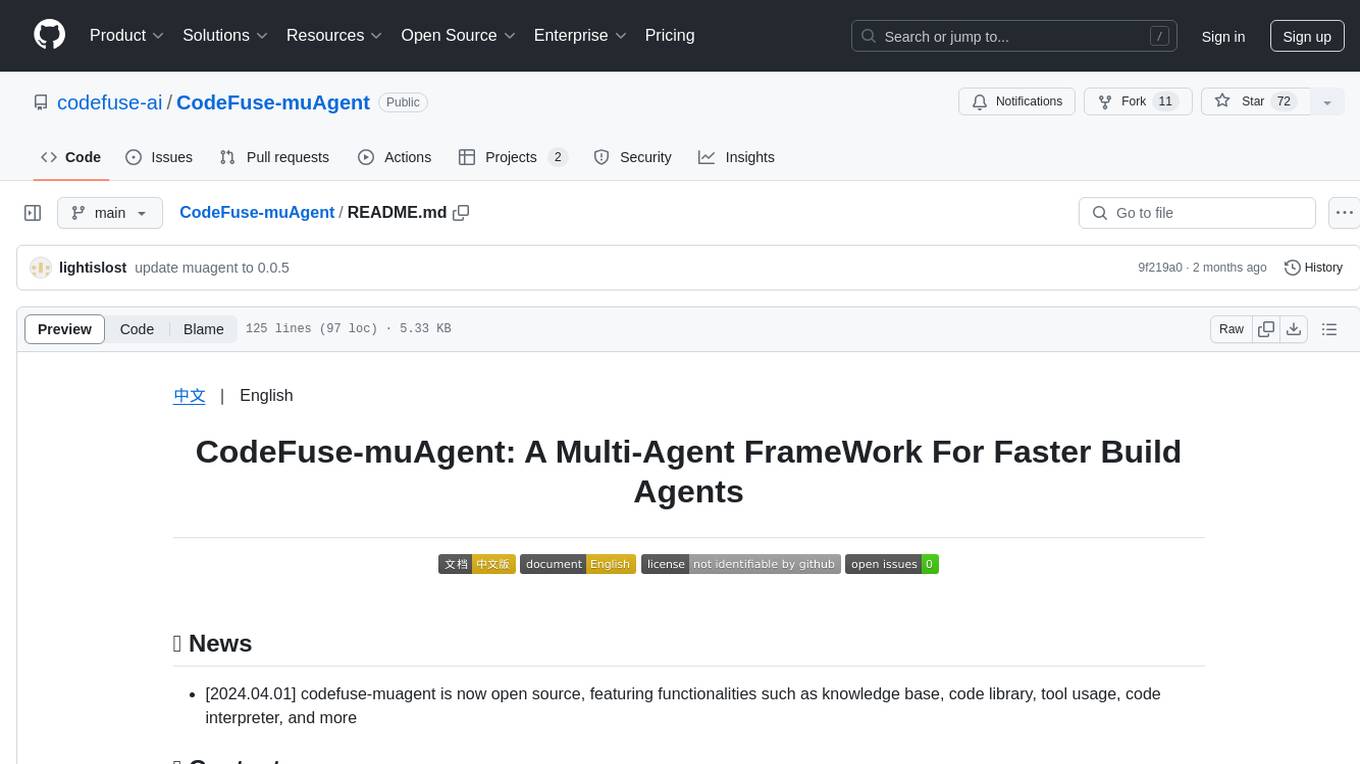
CodeFuse-muAgent
CodeFuse-muAgent is a Multi-Agent framework designed to streamline Standard Operating Procedure (SOP) orchestration for agents. It integrates toolkits, code libraries, knowledge bases, and sandbox environments for rapid construction of complex Multi-Agent interactive applications. The framework enables efficient execution and handling of multi-layered and multi-dimensional tasks.
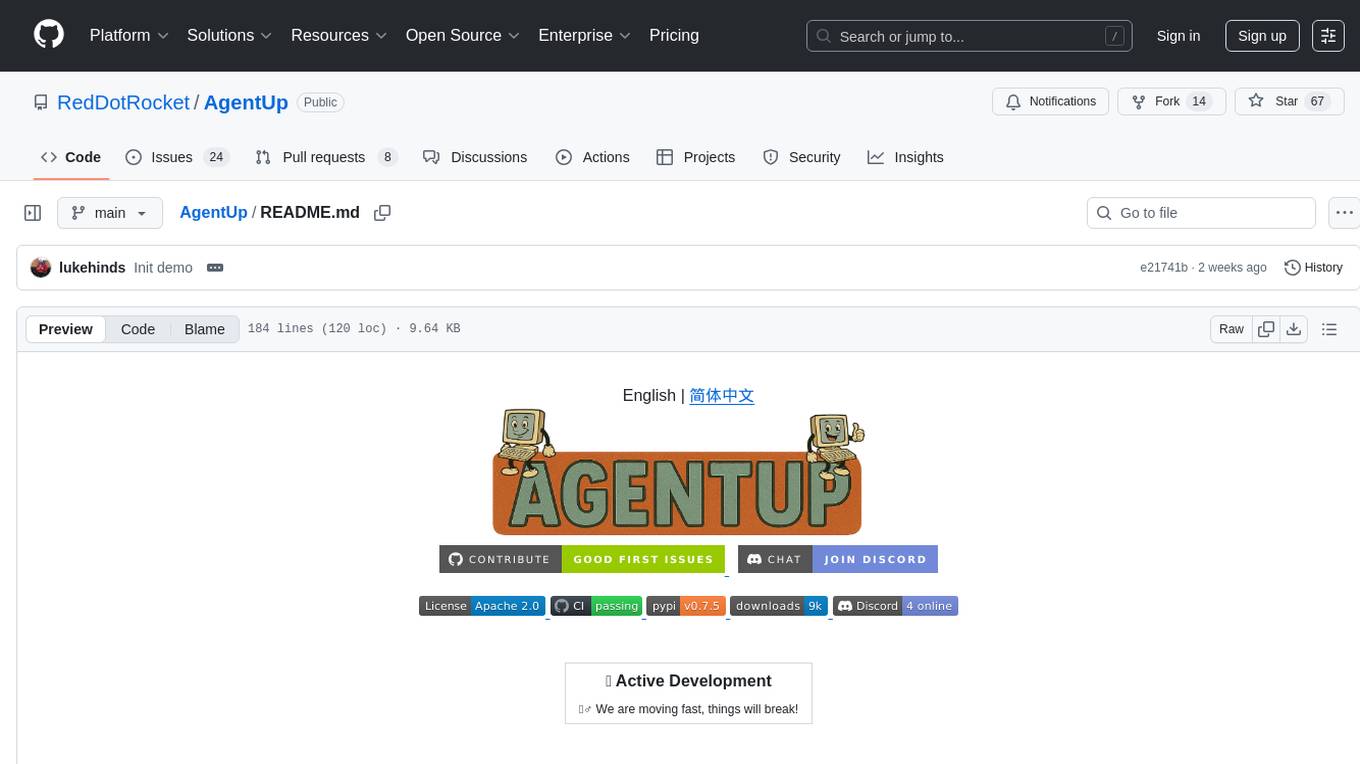
AgentUp
AgentUp is an active development tool that provides a developer-first agent framework for creating AI agents with enterprise-grade infrastructure. It allows developers to define agents with configuration, ensuring consistent behavior across environments. The tool offers secure design, configuration-driven architecture, extensible ecosystem for customizations, agent-to-agent discovery, asynchronous task architecture, deterministic routing, and MCP support. It supports multiple agent types like reactive agents and iterative agents, making it suitable for chatbots, interactive applications, research tasks, and more. AgentUp is built by experienced engineers from top tech companies and is designed to make AI agents production-ready, secure, and reliable.
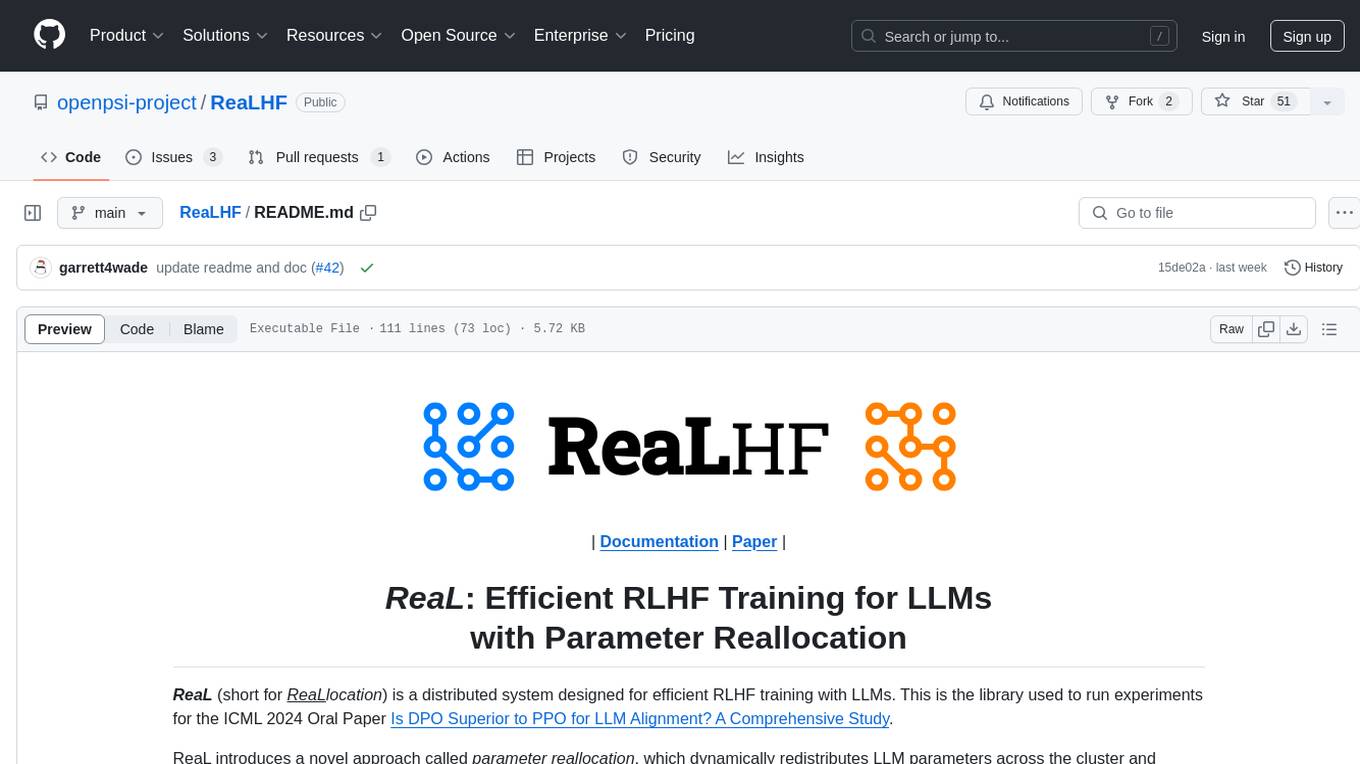
ReaLHF
ReaLHF is a distributed system designed for efficient RLHF training with Large Language Models (LLMs). It introduces a novel approach called parameter reallocation to dynamically redistribute LLM parameters across the cluster, optimizing allocations and parallelism for each computation workload. ReaL minimizes redundant communication while maximizing GPU utilization, achieving significantly higher Proximal Policy Optimization (PPO) training throughput compared to other systems. It supports large-scale training with various parallelism strategies and enables memory-efficient training with parameter and optimizer offloading. The system seamlessly integrates with HuggingFace checkpoints and inference frameworks, allowing for easy launching of local or distributed experiments. ReaLHF offers flexibility through versatile configuration customization and supports various RLHF algorithms, including DPO, PPO, RAFT, and more, while allowing the addition of custom algorithms for high efficiency.
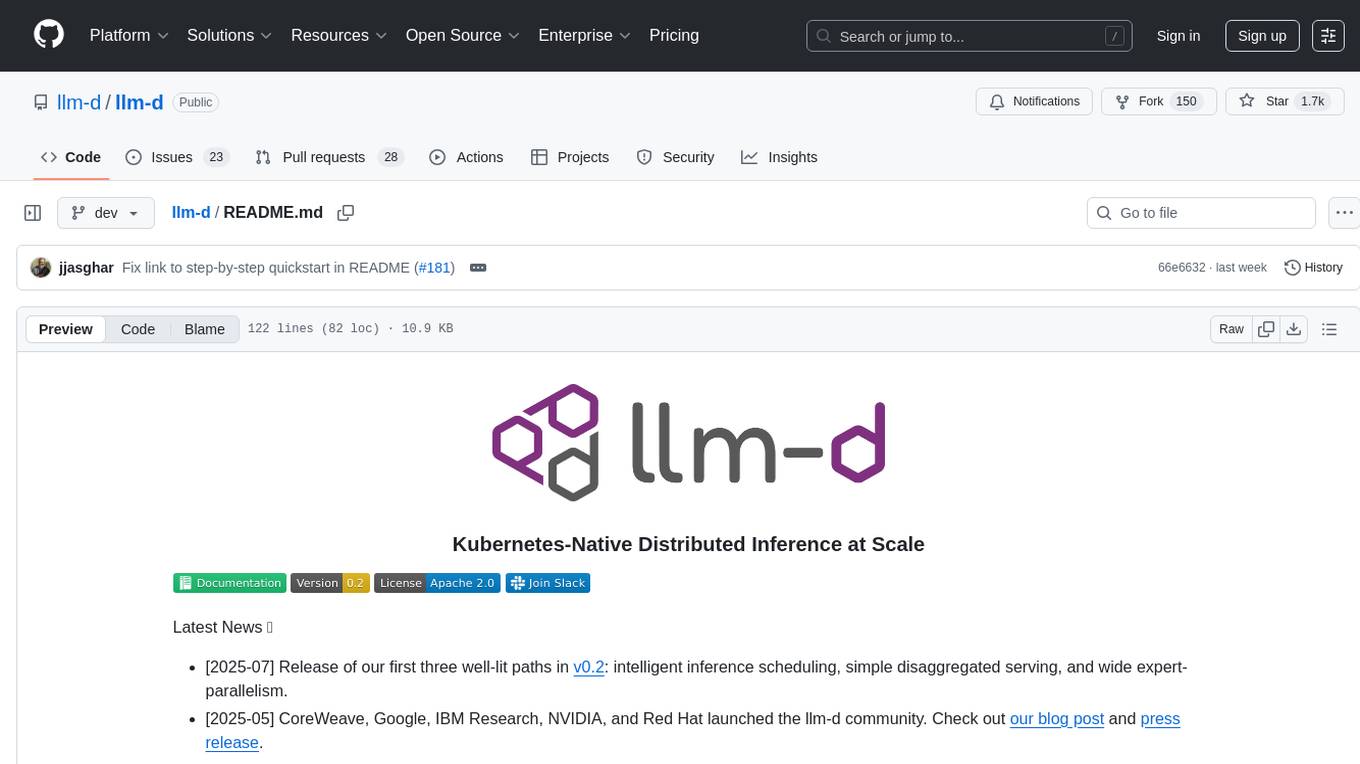
llm-d
LLM-D is a machine learning model for sentiment analysis. It is designed to classify text data into positive, negative, or neutral sentiment categories. The model is trained on a large dataset of labeled text samples and uses natural language processing techniques to analyze and predict sentiment in new text inputs. LLM-D is a powerful tool for businesses and researchers looking to understand customer feedback, social media sentiment, and other text data sources. It can be easily integrated into existing applications or used as a standalone tool for sentiment analysis tasks.

danswer
Danswer is an open-source Gen-AI Chat and Unified Search tool that connects to your company's docs, apps, and people. It provides a Chat interface and plugs into any LLM of your choice. Danswer can be deployed anywhere and for any scale - on a laptop, on-premise, or to cloud. Since you own the deployment, your user data and chats are fully in your own control. Danswer is MIT licensed and designed to be modular and easily extensible. The system also comes fully ready for production usage with user authentication, role management (admin/basic users), chat persistence, and a UI for configuring Personas (AI Assistants) and their Prompts. Danswer also serves as a Unified Search across all common workplace tools such as Slack, Google Drive, Confluence, etc. By combining LLMs and team specific knowledge, Danswer becomes a subject matter expert for the team. Imagine ChatGPT if it had access to your team's unique knowledge! It enables questions such as "A customer wants feature X, is this already supported?" or "Where's the pull request for feature Y?"
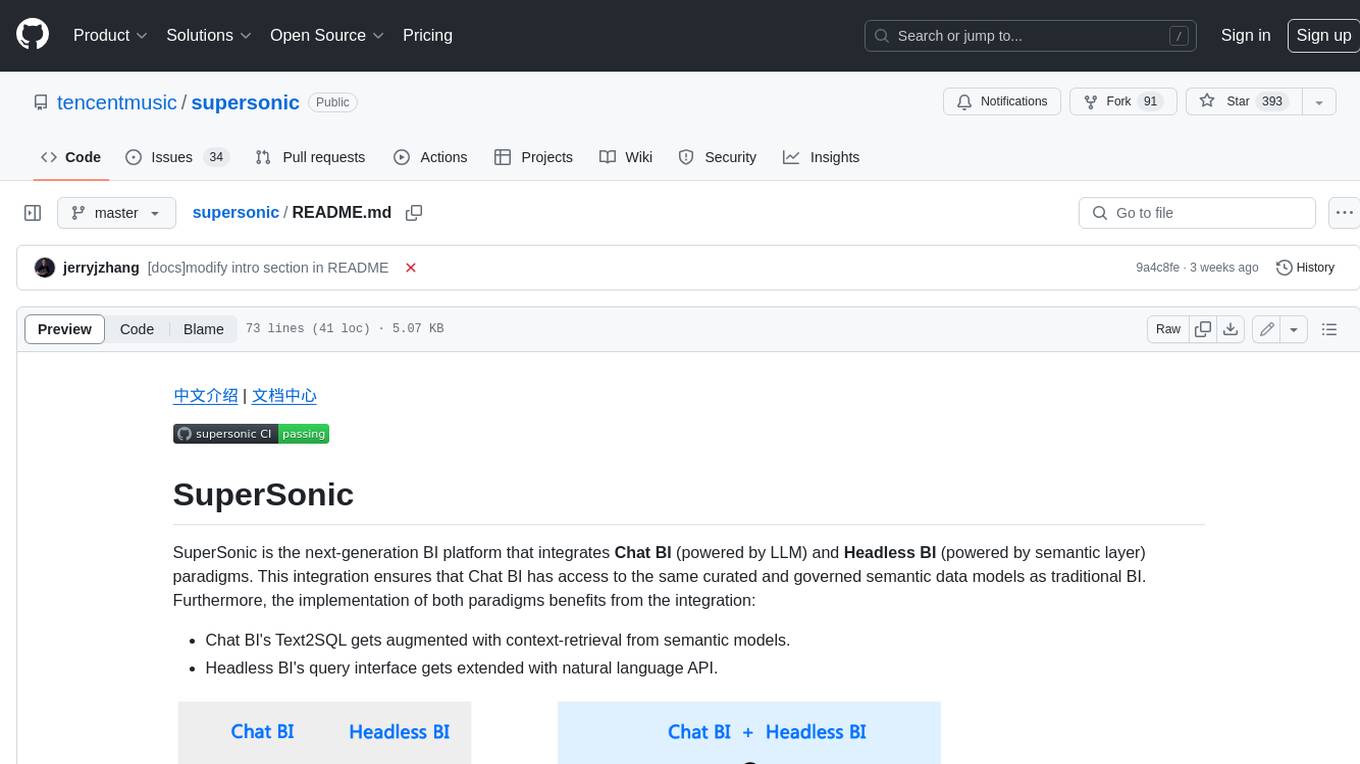
supersonic
SuperSonic is a next-generation BI platform that integrates Chat BI (powered by LLM) and Headless BI (powered by semantic layer) paradigms. This integration ensures that Chat BI has access to the same curated and governed semantic data models as traditional BI. Furthermore, the implementation of both paradigms benefits from the integration: * Chat BI's Text2SQL gets augmented with context-retrieval from semantic models. * Headless BI's query interface gets extended with natural language API. SuperSonic provides a Chat BI interface that empowers users to query data using natural language and visualize the results with suitable charts. To enable such experience, the only thing necessary is to build logical semantic models (definition of metric/dimension/tag, along with their meaning and relationships) through a Headless BI interface. Meanwhile, SuperSonic is designed to be extensible and composable, allowing custom implementations to be added and configured with Java SPI. The integration of Chat BI and Headless BI has the potential to enhance the Text2SQL generation in two dimensions: 1. Incorporate data semantics (such as business terms, column values, etc.) into the prompt, enabling LLM to better understand the semantics and reduce hallucination. 2. Offload the generation of advanced SQL syntax (such as join, formula, etc.) from LLM to the semantic layer to reduce complexity. With these ideas in mind, we develop SuperSonic as a practical reference implementation and use it to power our real-world products. Additionally, to facilitate further development we decide to open source SuperSonic as an extensible framework.
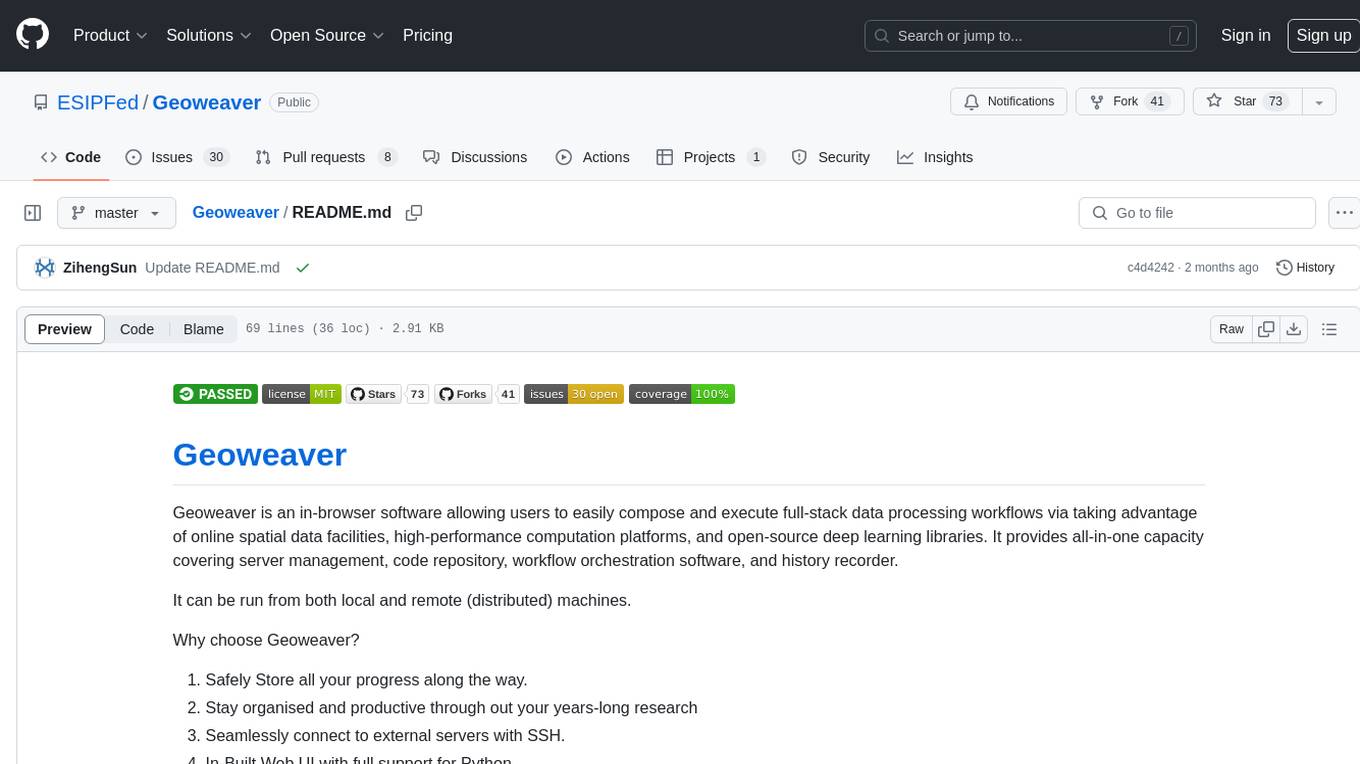
Geoweaver
Geoweaver is an in-browser software that enables users to easily compose and execute full-stack data processing workflows using online spatial data facilities, high-performance computation platforms, and open-source deep learning libraries. It provides server management, code repository, workflow orchestration software, and history recording capabilities. Users can run it from both local and remote machines. Geoweaver aims to make data processing workflows manageable for non-coder scientists and preserve model run history. It offers features like progress storage, organization, SSH connection to external servers, and a web UI with Python support.
For similar tasks

deeplake
Deep Lake is a Database for AI powered by a storage format optimized for deep-learning applications. Deep Lake can be used for: 1. Storing data and vectors while building LLM applications 2. Managing datasets while training deep learning models Deep Lake simplifies the deployment of enterprise-grade LLM-based products by offering storage for all data types (embeddings, audio, text, videos, images, pdfs, annotations, etc.), querying and vector search, data streaming while training models at scale, data versioning and lineage, and integrations with popular tools such as LangChain, LlamaIndex, Weights & Biases, and many more. Deep Lake works with data of any size, it is serverless, and it enables you to store all of your data in your own cloud and in one place. Deep Lake is used by Intel, Bayer Radiology, Matterport, ZERO Systems, Red Cross, Yale, & Oxford.
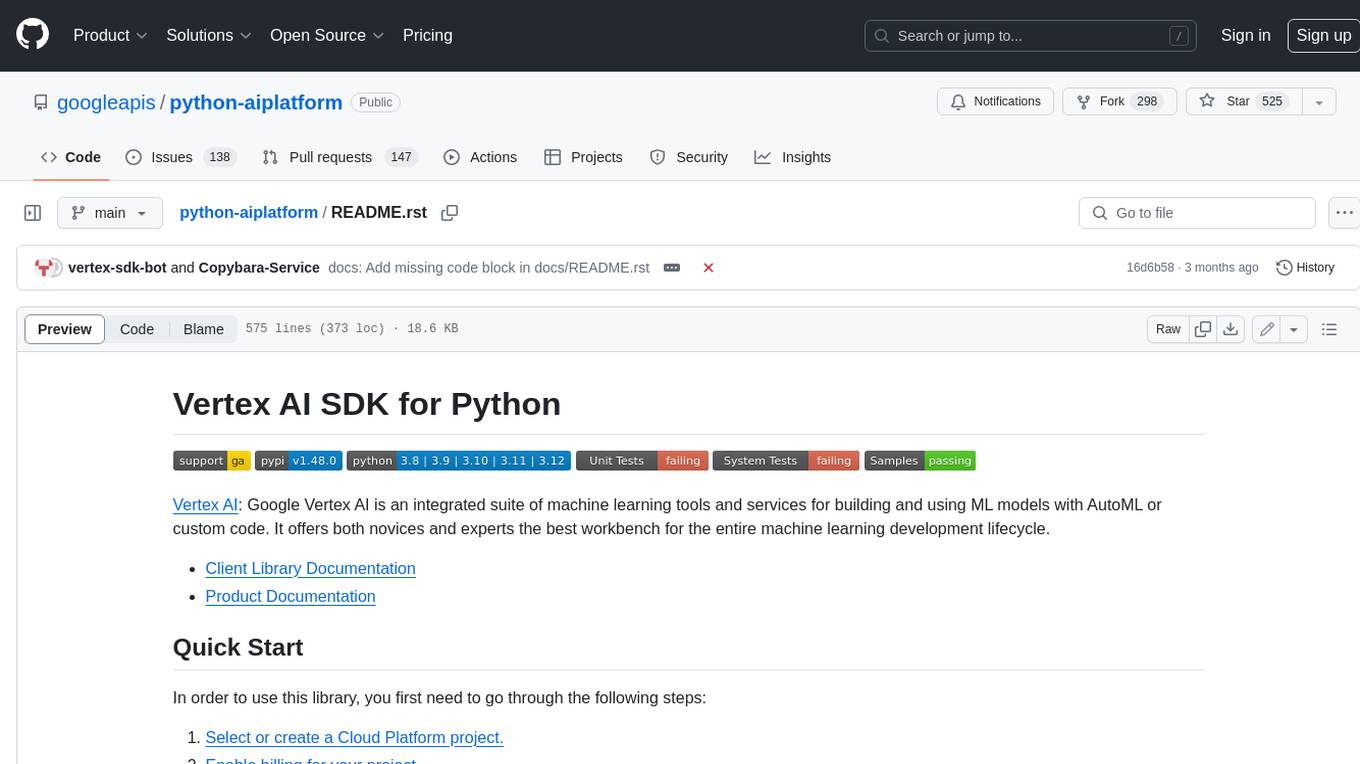
python-aiplatform
The Vertex AI SDK for Python is a library that provides a convenient way to use the Vertex AI API. It offers a high-level interface for creating and managing Vertex AI resources, such as datasets, models, and endpoints. The SDK also provides support for training and deploying custom models, as well as using AutoML models. With the Vertex AI SDK for Python, you can quickly and easily build and deploy machine learning models on Vertex AI.
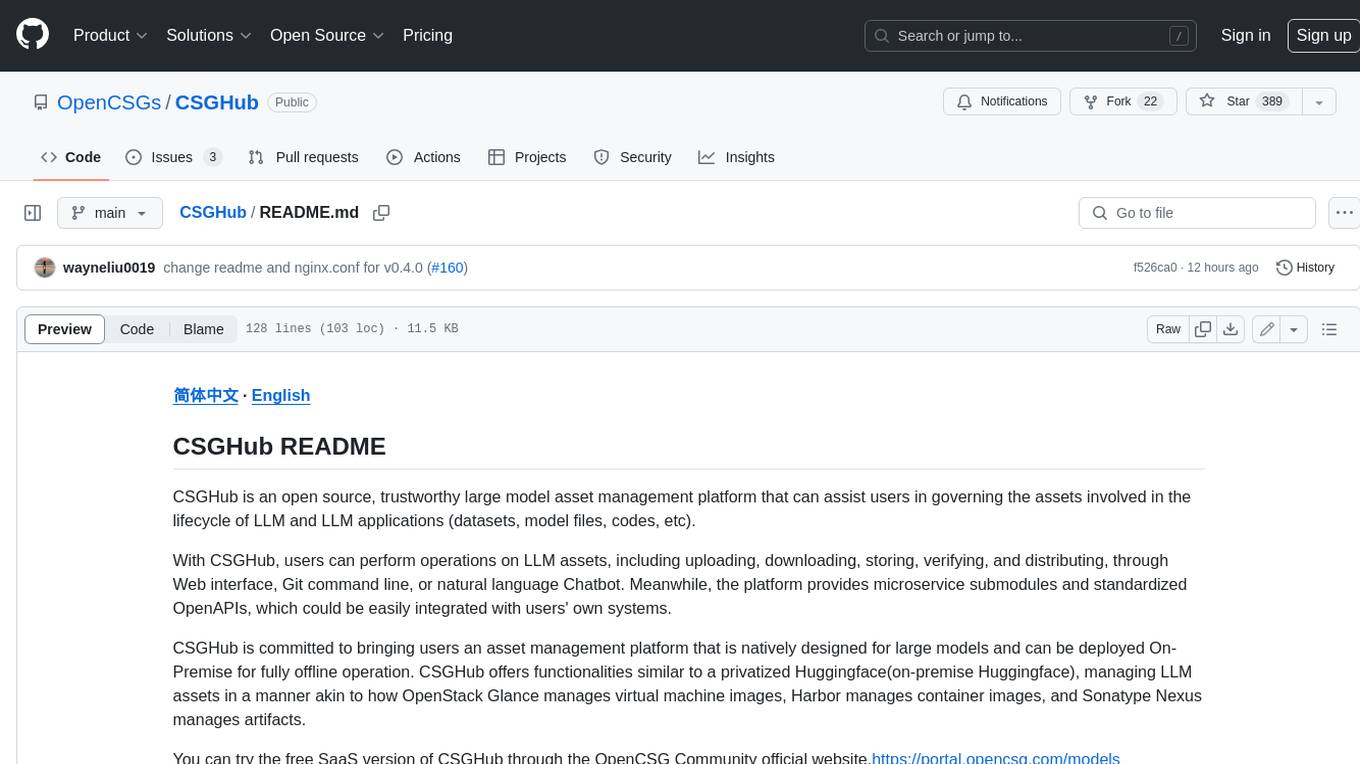
CSGHub
CSGHub is an open source, trustworthy large model asset management platform that can assist users in governing the assets involved in the lifecycle of LLM and LLM applications (datasets, model files, codes, etc). With CSGHub, users can perform operations on LLM assets, including uploading, downloading, storing, verifying, and distributing, through Web interface, Git command line, or natural language Chatbot. Meanwhile, the platform provides microservice submodules and standardized OpenAPIs, which could be easily integrated with users' own systems. CSGHub is committed to bringing users an asset management platform that is natively designed for large models and can be deployed On-Premise for fully offline operation. CSGHub offers functionalities similar to a privatized Huggingface(on-premise Huggingface), managing LLM assets in a manner akin to how OpenStack Glance manages virtual machine images, Harbor manages container images, and Sonatype Nexus manages artifacts.
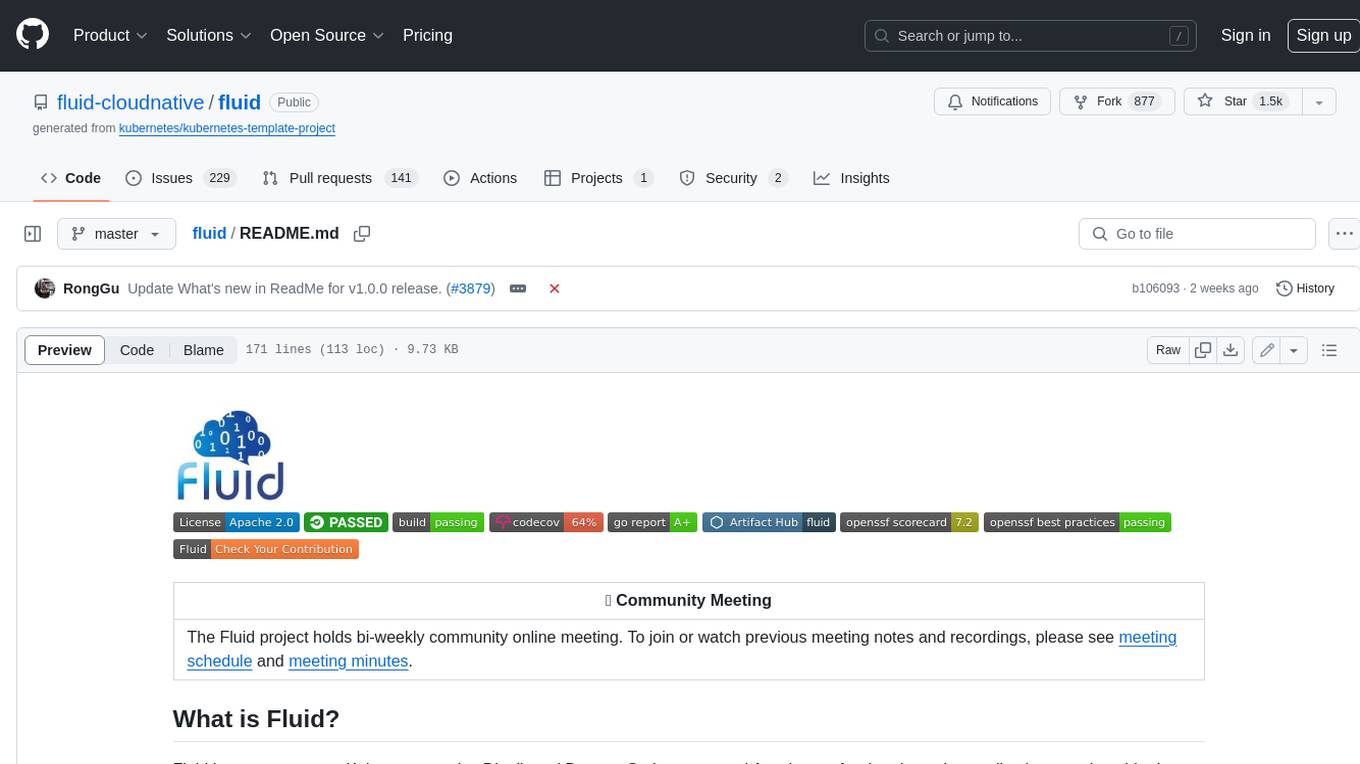
fluid
Fluid is an open source Kubernetes-native Distributed Dataset Orchestrator and Accelerator for data-intensive applications, such as big data and AI applications. It implements dataset abstraction, scalable cache runtime, automated data operations, elasticity and scheduling, and is runtime platform agnostic. Key concepts include Dataset and Runtime. Prerequisites include Kubernetes version > 1.16, Golang 1.18+, and Helm 3. The tool offers features like accelerating remote file accessing, machine learning, accelerating PVC, preloading dataset, and on-the-fly dataset cache scaling. Contributions are welcomed, and the project is under the Apache 2.0 license with a vendor-neutral approach.
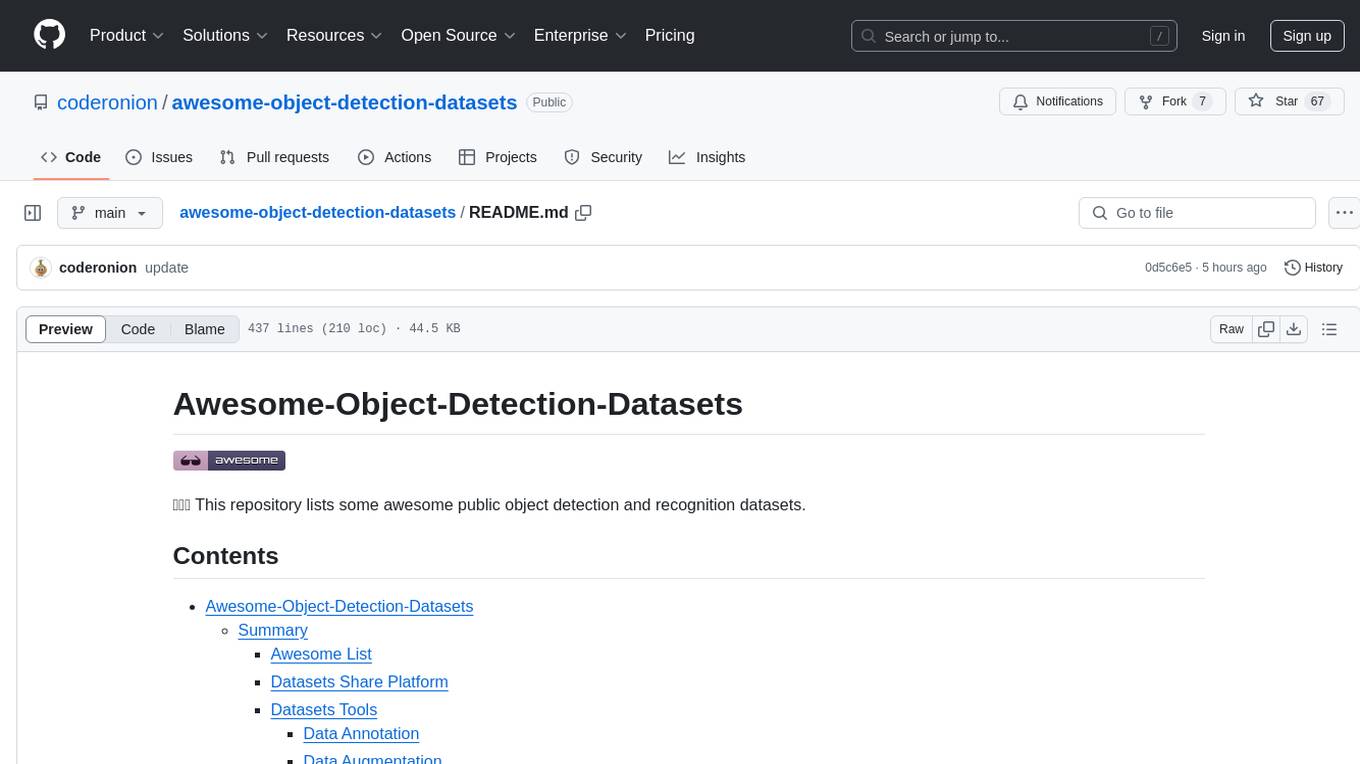
awesome-object-detection-datasets
This repository is a curated list of awesome public object detection and recognition datasets. It includes a wide range of datasets related to object detection and recognition tasks, such as general detection and recognition datasets, autonomous driving datasets, adverse weather datasets, person detection datasets, anti-UAV datasets, optical aerial imagery datasets, low-light image datasets, infrared image datasets, SAR image datasets, multispectral image datasets, 3D object detection datasets, vehicle-to-everything field datasets, super-resolution field datasets, and face detection and recognition datasets. The repository also provides information on tools for data annotation, data augmentation, and data management related to object detection tasks.
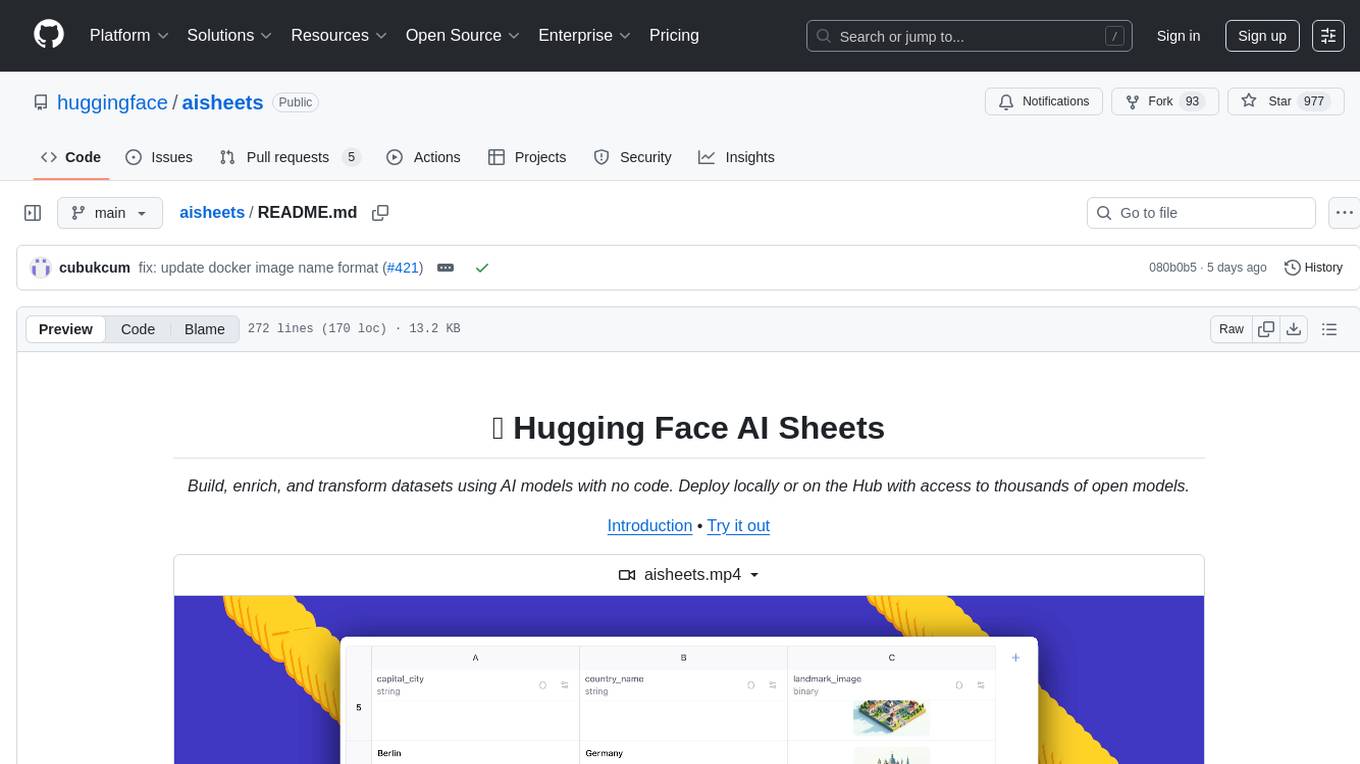
aisheets
Hugging Face AI Sheets is an open-source tool for building, enriching, and transforming datasets using AI models with no code. It can be deployed locally or on the Hub, providing access to thousands of open models. Users can easily generate datasets, run data generation scripts, and customize inference endpoints for text generation. The tool supports custom LLMs and offers advanced configuration options for authentication, inference, and miscellaneous settings. With AI Sheets, users can leverage the power of AI models without writing any code, making dataset management and transformation efficient and accessible.
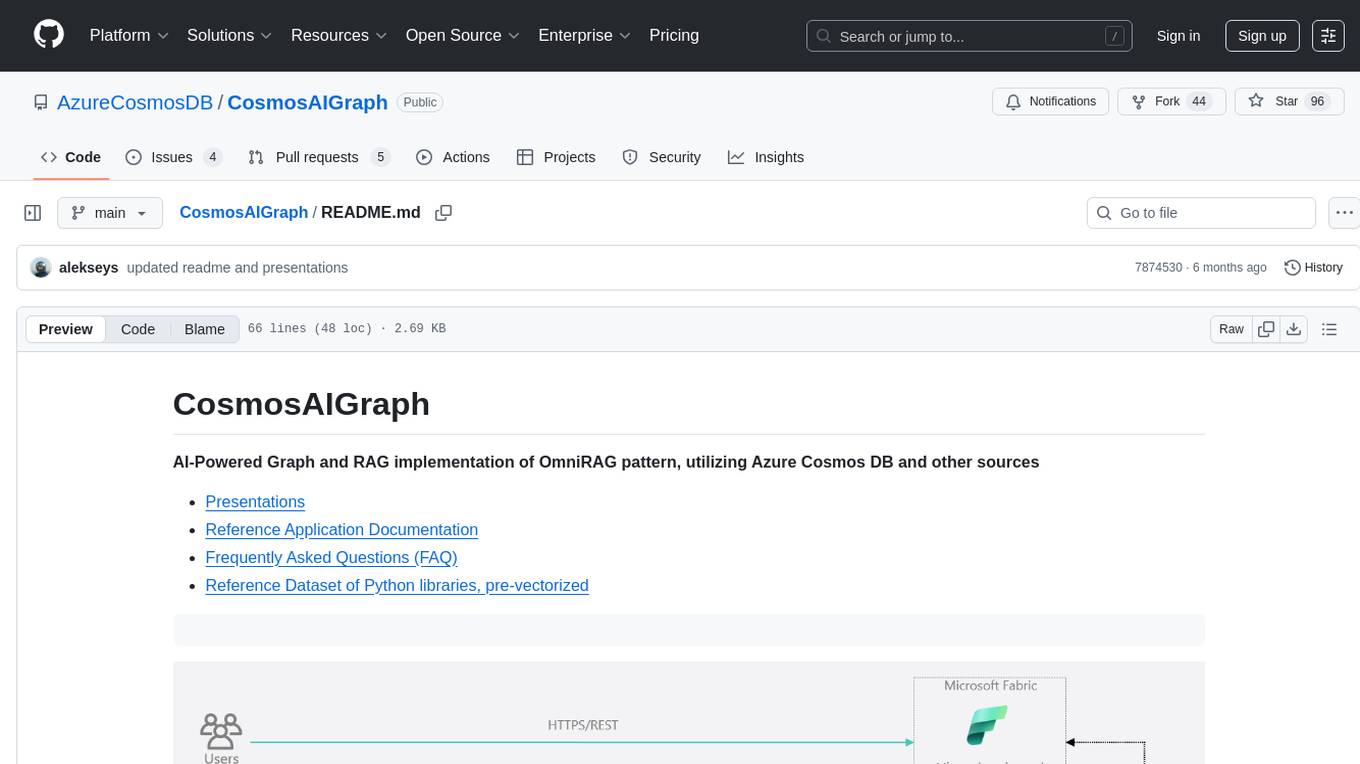
CosmosAIGraph
CosmosAIGraph is an AI-powered graph and RAG implementation of OmniRAG pattern, utilizing Azure Cosmos DB and other sources. It includes presentations, reference application documentation, FAQs, and a reference dataset of Python libraries pre-vectorized. The project focuses on Azure Cosmos DB for NoSQL and Apache Jena implementation for the in-memory RDF graph. It provides DockerHub images, with plans to add RBAC and Microsoft Entra ID/AAD authentication support, update AI model to gpt-4.5, and offer generic graph examples with a graph generation solution.
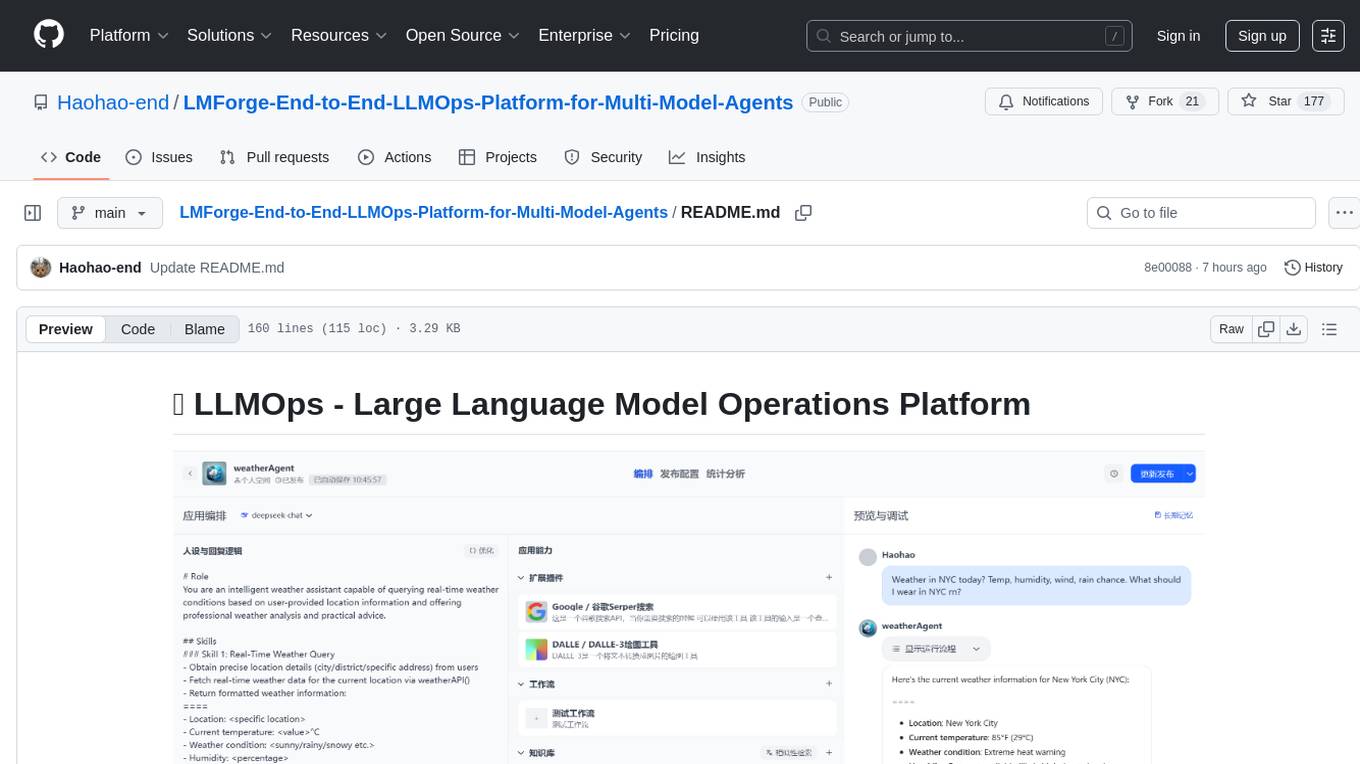
LMForge-End-to-End-LLMOps-Platform-for-Multi-Model-Agents
LMForge is an end-to-end LLMOps platform designed for multi-model agents. It provides a comprehensive solution for managing and deploying large language models efficiently. The platform offers tools for training, fine-tuning, and deploying various types of language models, enabling users to streamline the development and deployment process. With LMForge, users can easily experiment with different model architectures, optimize hyperparameters, and scale their models to meet specific requirements. The platform also includes features for monitoring model performance, managing datasets, and collaborating with team members, making it a versatile tool for researchers and developers working with language models.
For similar jobs
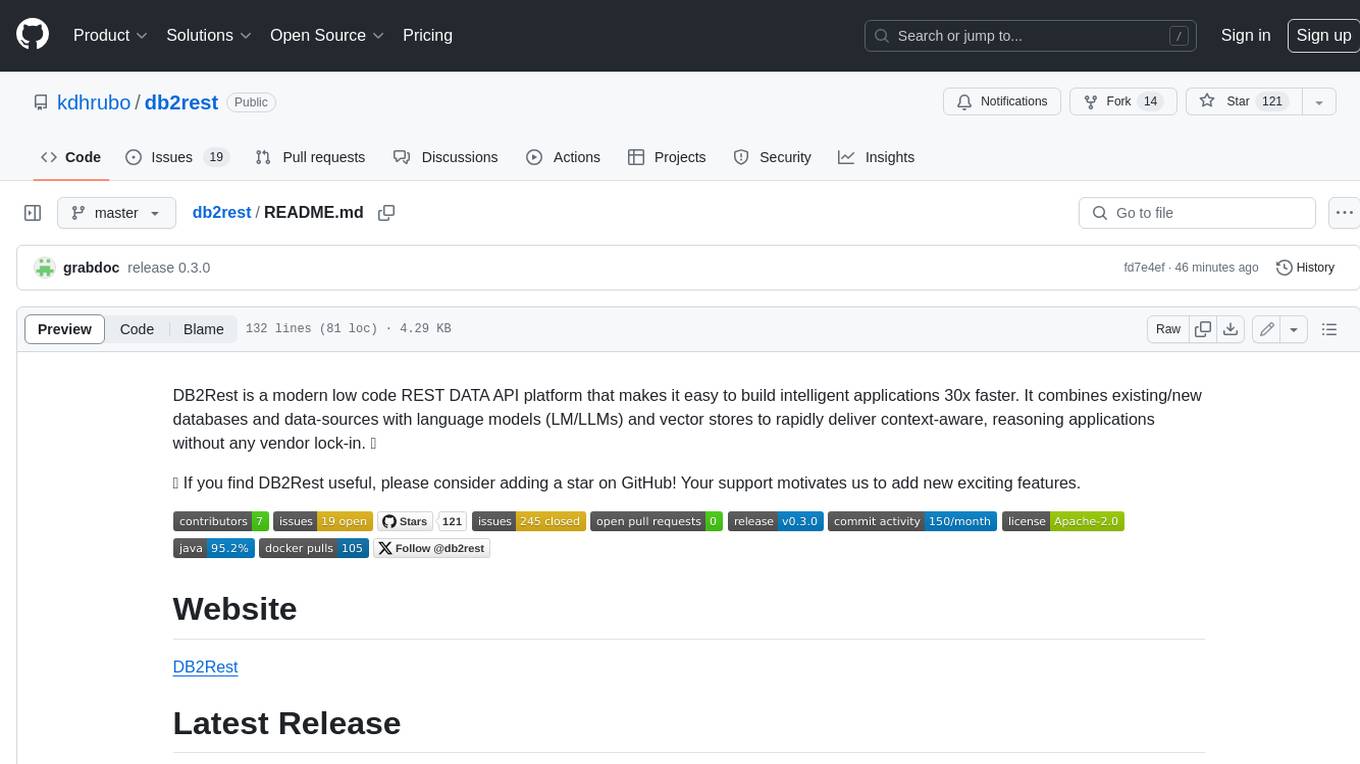
db2rest
DB2Rest is a modern low-code REST DATA API platform that simplifies the development of intelligent applications. It seamlessly integrates existing and new databases with language models (LMs/LLMs) and vector stores, enabling the rapid delivery of context-aware, reasoning applications without vendor lock-in.
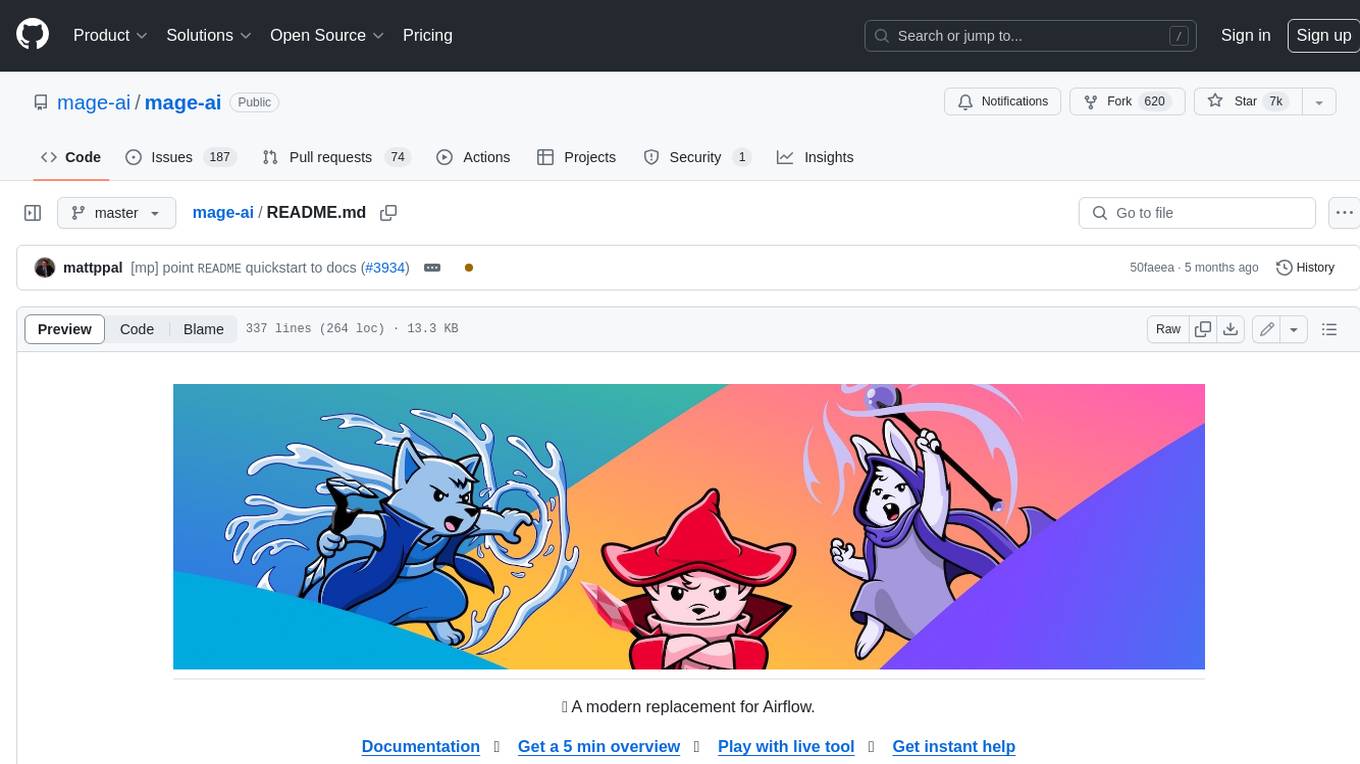
mage-ai
Mage is an open-source data pipeline tool for transforming and integrating data. It offers an easy developer experience, engineering best practices built-in, and data as a first-class citizen. Mage makes it easy to build, preview, and launch data pipelines, and provides observability and scaling capabilities. It supports data integrations, streaming pipelines, and dbt integration.
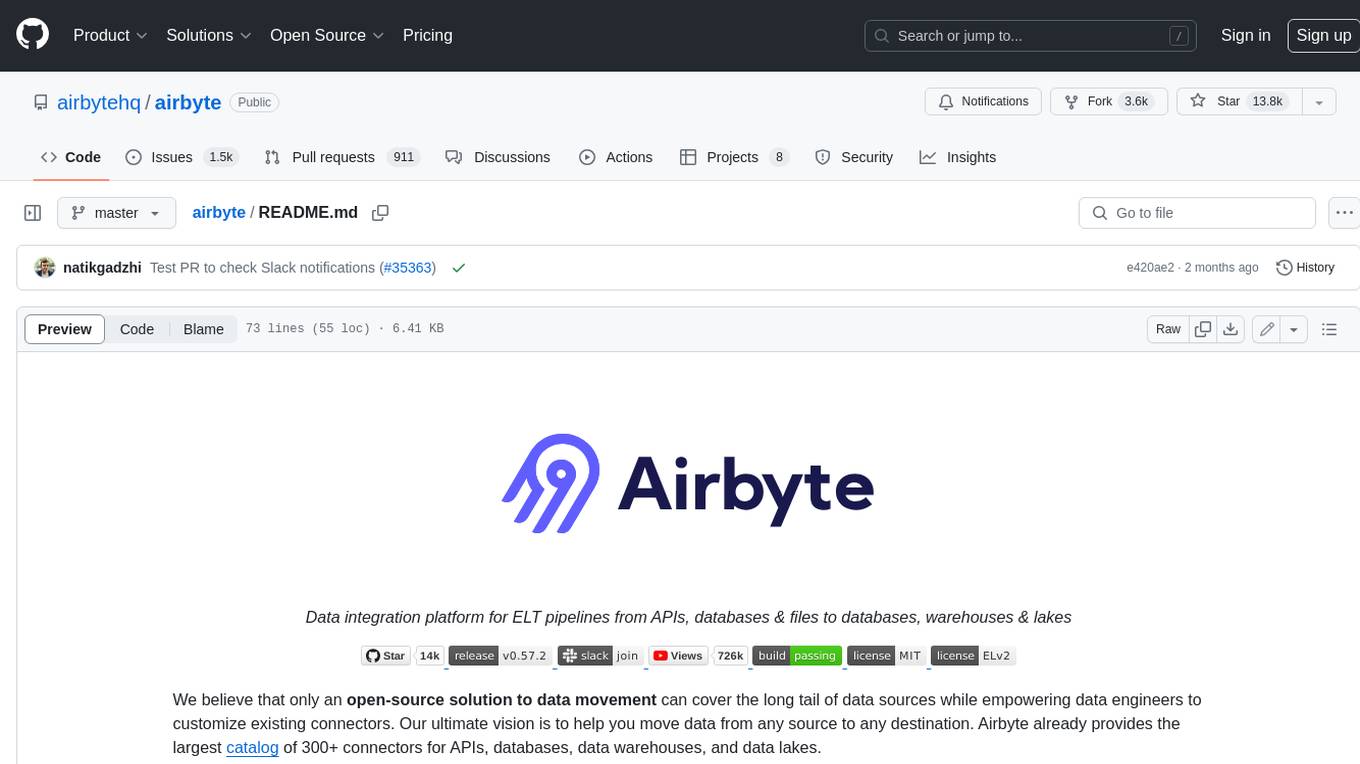
airbyte
Airbyte is an open-source data integration platform that makes it easy to move data from any source to any destination. With Airbyte, you can build and manage data pipelines without writing any code. Airbyte provides a library of pre-built connectors that make it easy to connect to popular data sources and destinations. You can also create your own connectors using Airbyte's no-code Connector Builder or low-code CDK. Airbyte is used by data engineers and analysts at companies of all sizes to build and manage their data pipelines.

labelbox-python
Labelbox is a data-centric AI platform for enterprises to develop, optimize, and use AI to solve problems and power new products and services. Enterprises use Labelbox to curate data, generate high-quality human feedback data for computer vision and LLMs, evaluate model performance, and automate tasks by combining AI and human-centric workflows. The academic & research community uses Labelbox for cutting-edge AI research.

telemetry-airflow
This repository codifies the Airflow cluster that is deployed at workflow.telemetry.mozilla.org (behind SSO) and commonly referred to as "WTMO" or simply "Airflow". Some links relevant to users and developers of WTMO: * The `dags` directory in this repository contains some custom DAG definitions * Many of the DAGs registered with WTMO don't live in this repository, but are instead generated from ETL task definitions in bigquery-etl * The Data SRE team maintains a WTMO Developer Guide (behind SSO)

airflow
Apache Airflow (or simply Airflow) is a platform to programmatically author, schedule, and monitor workflows. When workflows are defined as code, they become more maintainable, versionable, testable, and collaborative. Use Airflow to author workflows as directed acyclic graphs (DAGs) of tasks. The Airflow scheduler executes your tasks on an array of workers while following the specified dependencies. Rich command line utilities make performing complex surgeries on DAGs a snap. The rich user interface makes it easy to visualize pipelines running in production, monitor progress, and troubleshoot issues when needed.
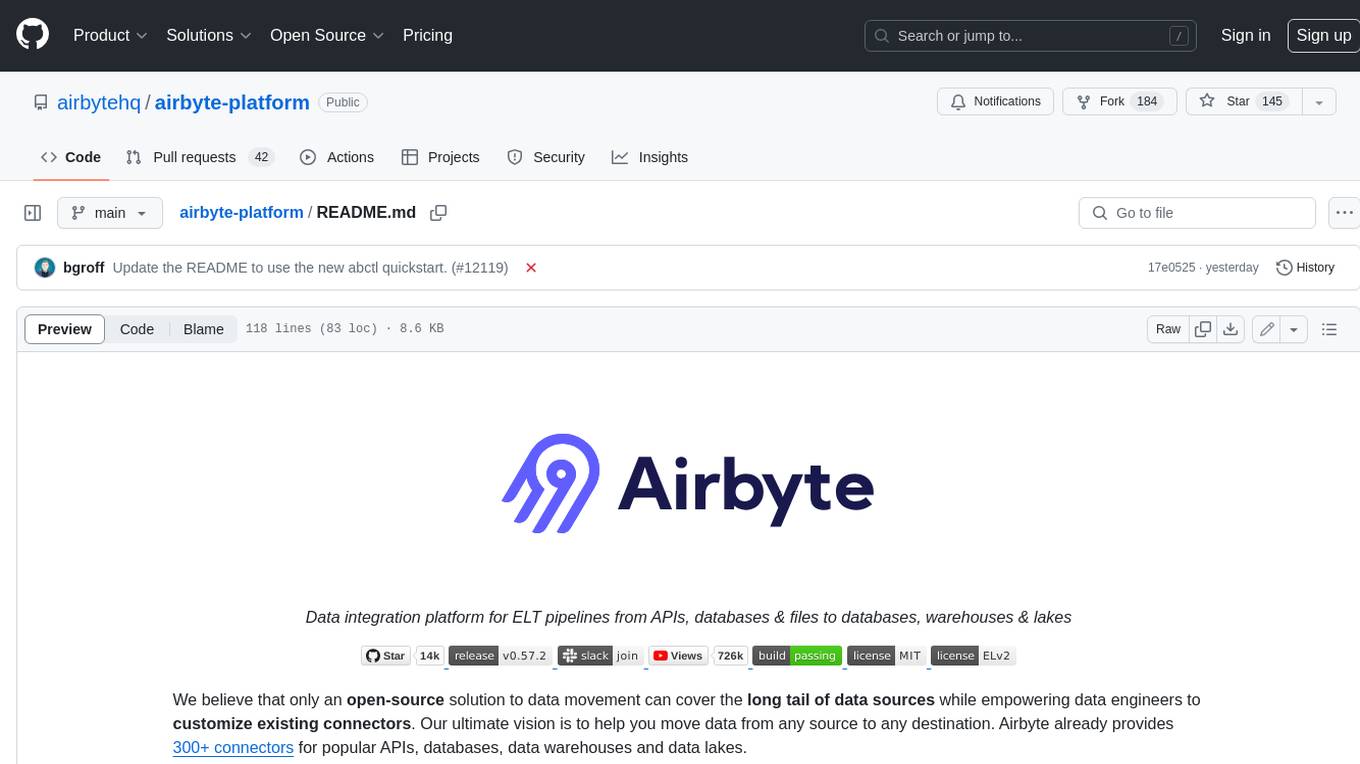
airbyte-platform
Airbyte is an open-source data integration platform that makes it easy to move data from any source to any destination. With Airbyte, you can build and manage data pipelines without writing any code. Airbyte provides a library of pre-built connectors that make it easy to connect to popular data sources and destinations. You can also create your own connectors using Airbyte's low-code Connector Development Kit (CDK). Airbyte is used by data engineers and analysts at companies of all sizes to move data for a variety of purposes, including data warehousing, data analysis, and machine learning.
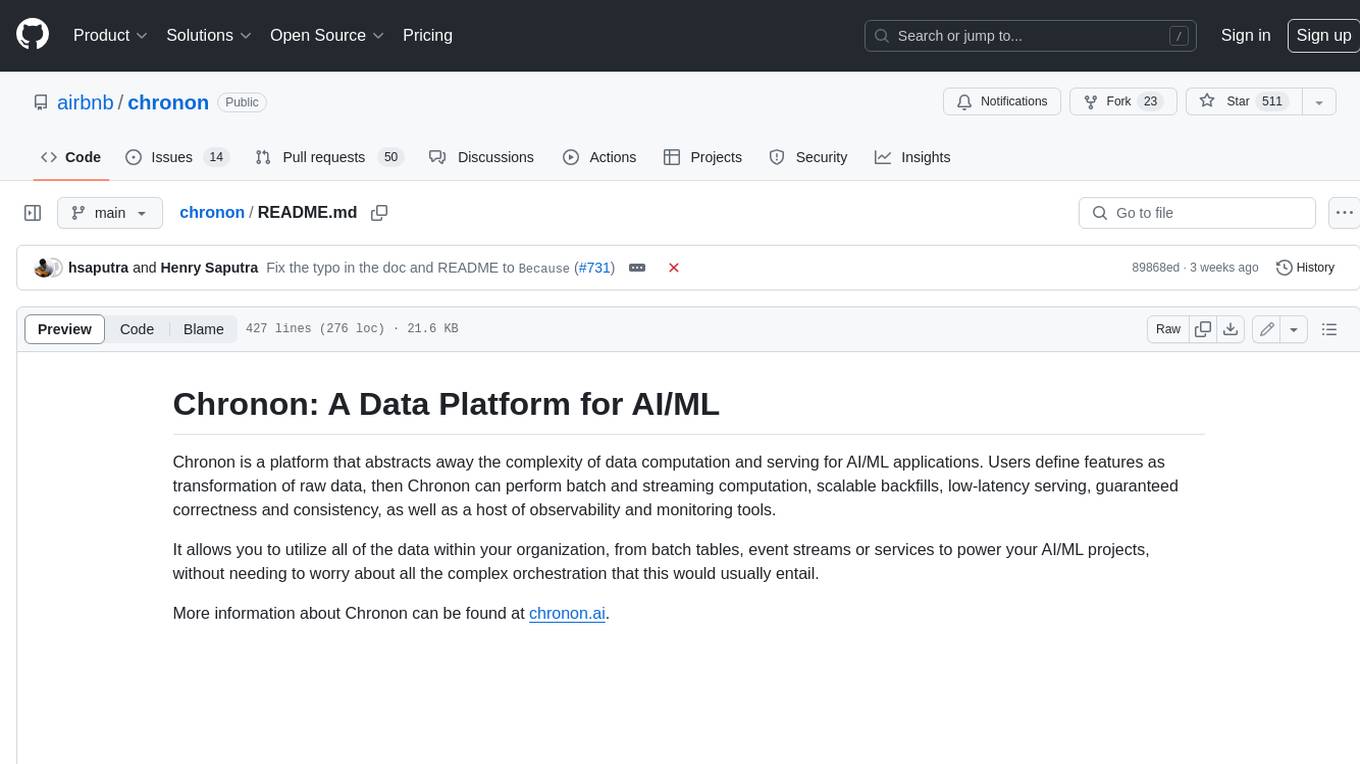
chronon
Chronon is a platform that simplifies and improves ML workflows by providing a central place to define features, ensuring point-in-time correctness for backfills, simplifying orchestration for batch and streaming pipelines, offering easy endpoints for feature fetching, and guaranteeing and measuring consistency. It offers benefits over other approaches by enabling the use of a broad set of data for training, handling large aggregations and other computationally intensive transformations, and abstracting away the infrastructure complexity of data plumbing.



